– Great landscapes and spectacular African wildlife

SAFARI – to observe and photograph wildlife – is my absolute favorite activity in South Africa. And the most impressive safari experiences I have had, are from
KRUGER NATIONAL PARK.
This big game reserve in the north-east of South Africa is my favorite place to go on a self drive safari.
It is fantastic to drive along – never knowing what you will see – but one thing is for certain – you will spot some animals and birds!
KRUGER NATIONAL PARK is one of the largest game reserves in Africa.
It covers an area of nearly 20.000 km2 – and is approximately 360 kilometers long. It has an average width of 65 kilometers and, at its widest point, it is 90 kilometers from east to west.
Kruger Park became South Africa’s first national park in 1926.

Kruger National Park is situated in the northeast of South Africa with the African provinces of Limpopo and Mpumalanga to the west and south, Zimbabwe in the north and Mozambique in the east.
Kruger has a network of some 1800 kilometers of well-maintained roads. Most roads are paved. Those roads made of gravel are good as well, there are no bad dirts roads. So it easy to get around in an ordinary car. Self drive safari is very popular in this park, but there are also tour operators and private concessions within the park for those who do not like driving on their own.
It is also very popular to stay overnight in one of the parks 21 rest camps. There are also 2 private lodge concessions, and 15 private safari lodges.
The 21 rest camps have several accommodation options. The basic accommodation types are camping sites, huts, safari tents, bungalows, cottages and guest houses.
12 Main camps – All these camps have electricity, a first-aid centre, a shop, braai and communal kitchen facilities, a laundromat/laundry tubs, a restaurant and/or self-service cafeteria, public telephones and a petrol station.
5 Bushveld camps: Camps that provide accommodation in smaller, more remote restcamps. Bush camps do not have shops or restaurants. Open verandas often serve as kitchen/dining room. All units have a refrigerator, cooking utensils, crockery, cutlery and a stove, either a two-plate stove without an oven or a four-plate stove with an oven in the larger units. All units have private ablution facilities.
4 Satelite camps: Smaller camps with self-catering accommodation and camping facilities. Balule has no electricity
In 2009 we stayed within the park at 4 different main camps – a very special and a great experience ! I have also in later occasions stayed at several camps, mostly in the southern part of the park.
I recommend to book accommodation in the park directly at The South African National Parks homepage: http://www.sanparks.org. Here you find both information about Kruger National Park and all the national parks in South Africa – including accommodation and activities at the different national parks.

Kruger Park has 9 entrance gates and before you are allowed to enter the park you have to register ( every person in the car) at the gate office, fill in a form and pay a conservation fee (entrance fee). The fee is higher for foreign visitors than for South African citizens and residents.
Consider to buy a WILD CARD if you are going to visit the park for several days or/and visit other national parks in South Africa. The WILDCARD is valid for one year and include free entrance to all the national parks in South Africa. Read more of this at www.sanparks.org. Remember to follow the park rules and regulations, you will get this information at the gate. Well – this is it – you are ready for a self drive safari!
MOMENTS..
You can stop where ever you want, for how long you want – to take your pictures or just to soak up the African atmosphere!
But be prepared to meet several other cars if there is an interesting animal by the road. Sometimes it can be a bit chaotic when everyone wants to have a glimpse of the animal, especially if there are cats around..
Then you just have to wait until the animals go away. If you are lucky an animal will pass close by your car. We have had several such experiences.
WILD LIFE
The reserve is home to 34 amphibia, 114 reptiles, 507 birds and 147 mammal species.
The «Big Five» – lions, leopards, rhinos, elephants and buffalos – have become something of a quest for many people on safari, and the Kruger National Park has more than its fair share of these!
Most recent (2010-2011) estimated numbers of mammals:
(from the website sanparks.org)
| BIG5: | |
| Lion | 1 620 – 1750 |
| Leopard | 1 000 |
| Elephant | 13 750 |
| Buffalo | 37 130 |
| Rhino ( # from another source) | 5 000 |
| OTHER MAMMALS: | |
| Cheetah | 120 |
| Wild dog | 120 |
| Spotted hyena | 5340 |
| Burchell’s zebra | 23 700 – 35 300 |
| Hippopotamus | 3 100 |
| Crocodile | 4420 |
| Warthog | 3 100 – 5 700 |
| Giraffe | 6 800 – 10 300 |
| Eland | 460 |
| Roan antelope | 90 |
| Sable antelope | 290 |
| Greater kudu | 11 200 – 17 300 |
| Nyala | >300 |
| Waterbuck | 3 100 – 7 800 |
| Reedbuck | 300 |
| Mountain reedbuck | 150 |
| Blue wildebeest | 6 400 – 13 100 |
| Tsessebe | 220 |
| Impala | 132 300 – 176 400 |
| Crocodile |
Information about the different regions, with their main camps, wildlife opportunities – including some of my sightings:
NORTHERN REGION
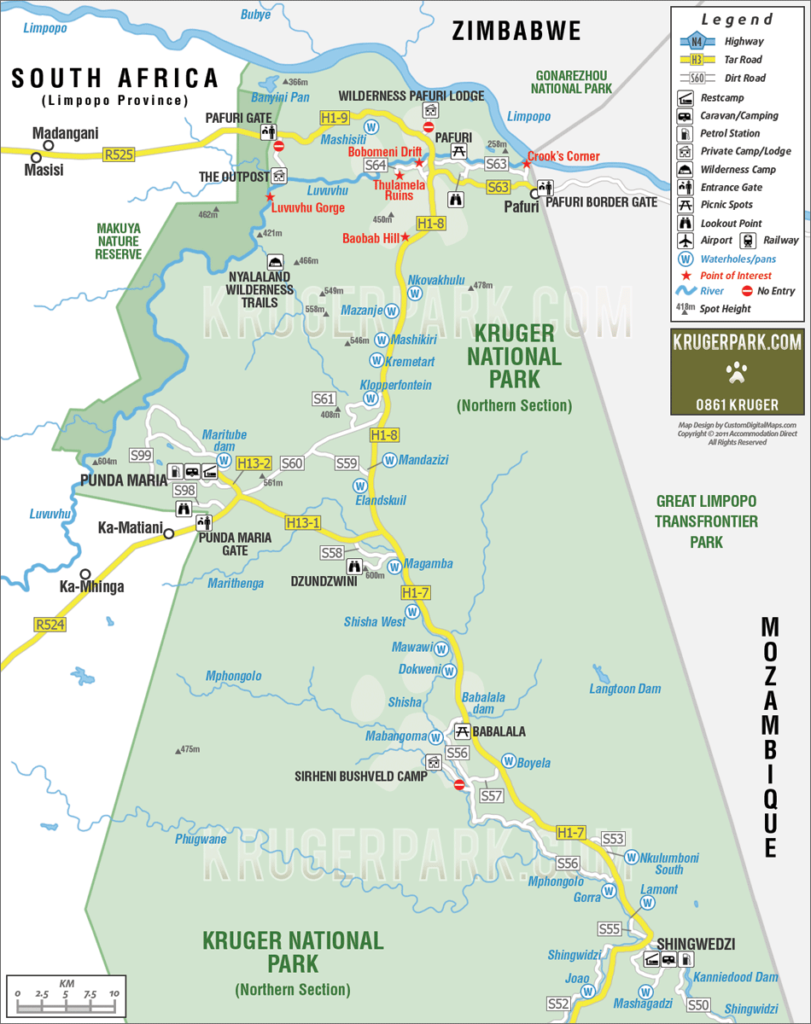
Northern part of Kruger N. Park. (Great maps of Kruger at www.safari.com) 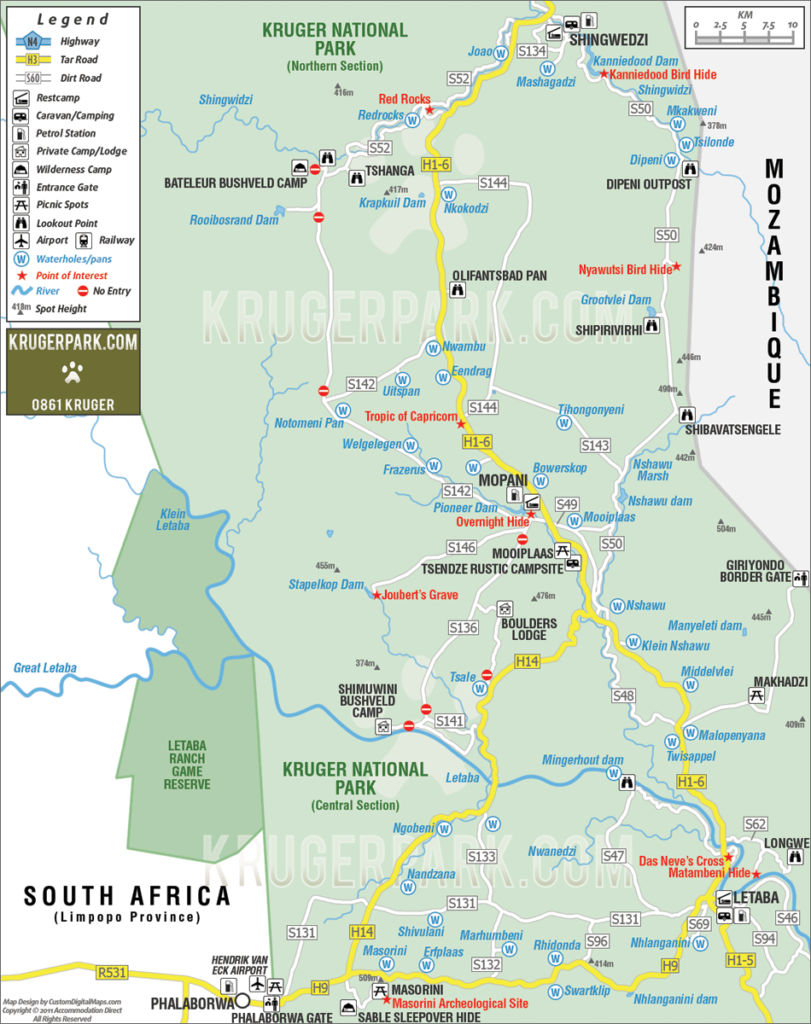
The northern region, north of Letaba Camp, has three main camps:
Punda Maria, Shingwedzi and Letaba.
There are also some bush-camps in this part of the park : Bateleur, Shimuwini and Sirheni – which only offer self-catering cottages.
And in the far north section – there is Pafuri Border Camp, which is a private luxury tented camp. There are no shops or restaurant facilities in Pafuri, but the kitchen has a gas stove with oven, refrigerator, freezer, cutlery and crockery.
Pafuri Border Camp camp is situated along the banks of the Luvuvhu River, and is renowned as one of the best birding destinations in South Africa, with the chance of seeing a variety of rarely seen species.
PUNTA MARIA AND SURROUNDINGS
Punta Maria is the most northern public rest camp, and is located in the sandveld vegetation. Zebra, buffalo, kudu and nyala are common in the area, while eland, sable antelope and wild dogs are seen regularly. This area is also a great birding destination – with a chance to see a number of rare species including crested guinafowl and Pel´s fishing owl.
Big5: Elephant and buffalo are common and also leopard are seen regularly. But rhino and lion are hard to find this far north.
SHINGWEDZI AND SURROUNDINGS
Shingwedzi Camp – a medium sized camp in the heart of the mopane shrub- veld. It benefits from the proximity of the Shingwedzi River and the Kaniedood Dam which attract most of the game in this area.
The camp facilities include accommodation, restaurant, swimming pool, cafeteria and laundry.
The north of Shingwedzi, in the Balalala area, is a good place to see roan, sable, tsessebe, eland and Lichtenstein´s hartebeest. Kudu, bushbuck, nyala, waterbuck and spotted hyena are common.
Big5: Elephants and buffalo are common, especially near Kanniedood Dam on the Shingwedzi River, 1o km south of the camp. Rhino can be spotted, but less common. A large Lion pride is in the area and leopard are often seen in the riverine areas.

We were lucky to see leopard, the second day at the park. It was just south of Shingwedzi, in the beginning of the S52 route . The leopard was coming from the river area, crossed the gravel road in front of us and disappeared in the grass at the other side.
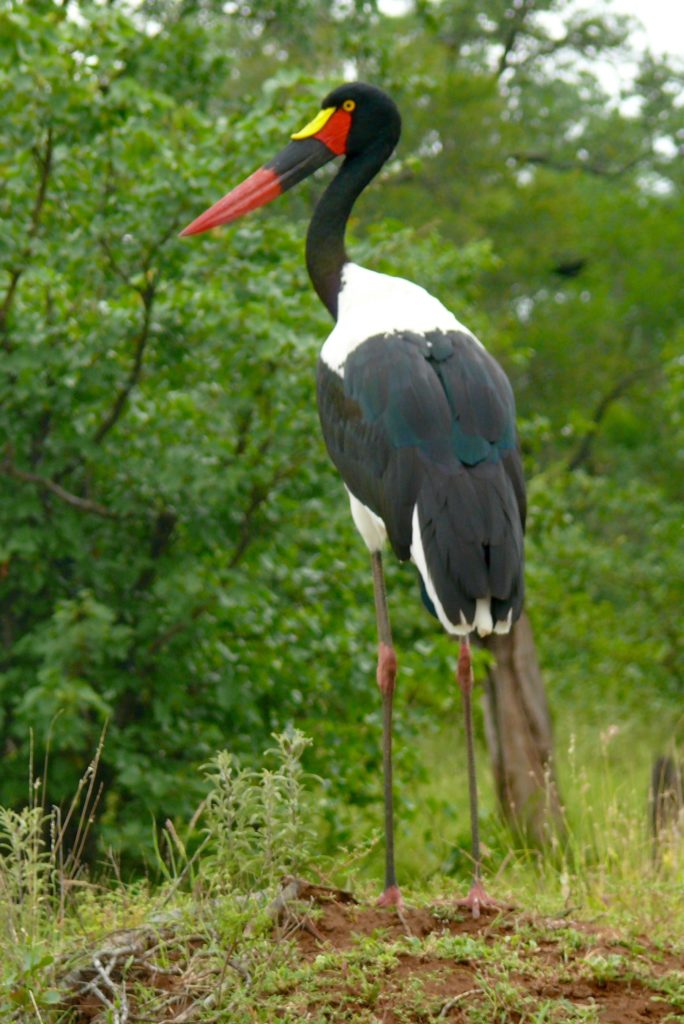
Saddle-billed stork – also near the river.
This is one of the “Big 6“ birds, which are 6 bird species selected by park officials for their uniqueness. The six are:
– ground hornbill
– kori bustard
– lappet-faced vulture
– martial eagle
– pel’s fishing owl
– saddle-bill stork
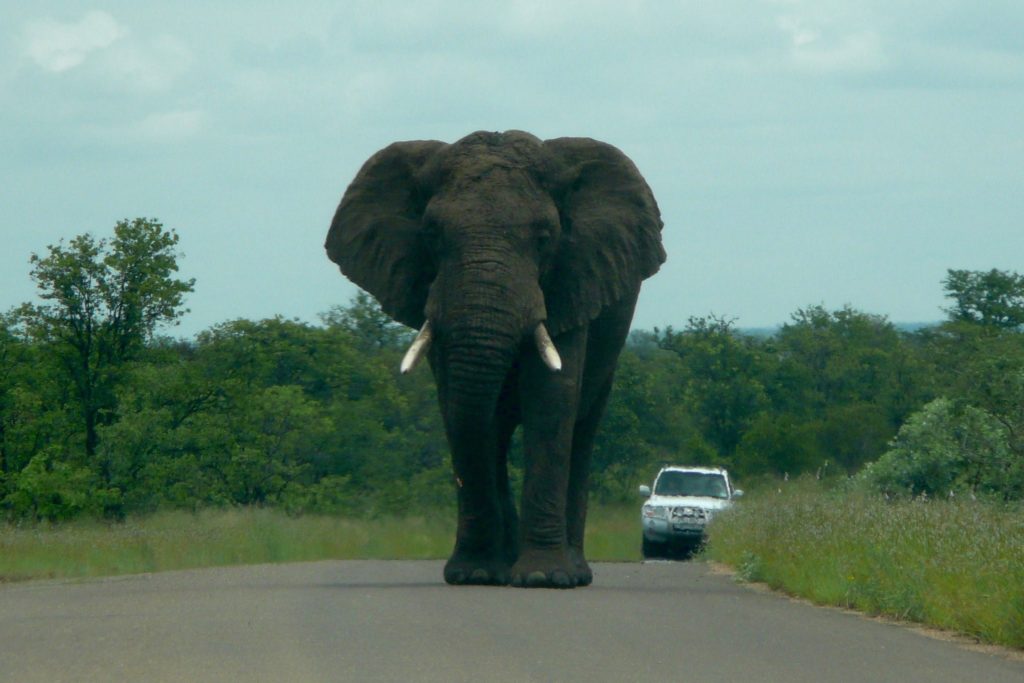
MOPANI AND SURROUNDINGS
Mopani Rest Camp – is named after the mopane-trees that surrounds the camp. It is located on at a hillside covered with mopane-trees – overlooking the Pioneer Dam. It is the newest and most comfortable rest camp in the the park.
Has a swimming pool and a very good restaurant with a great view of the dam.
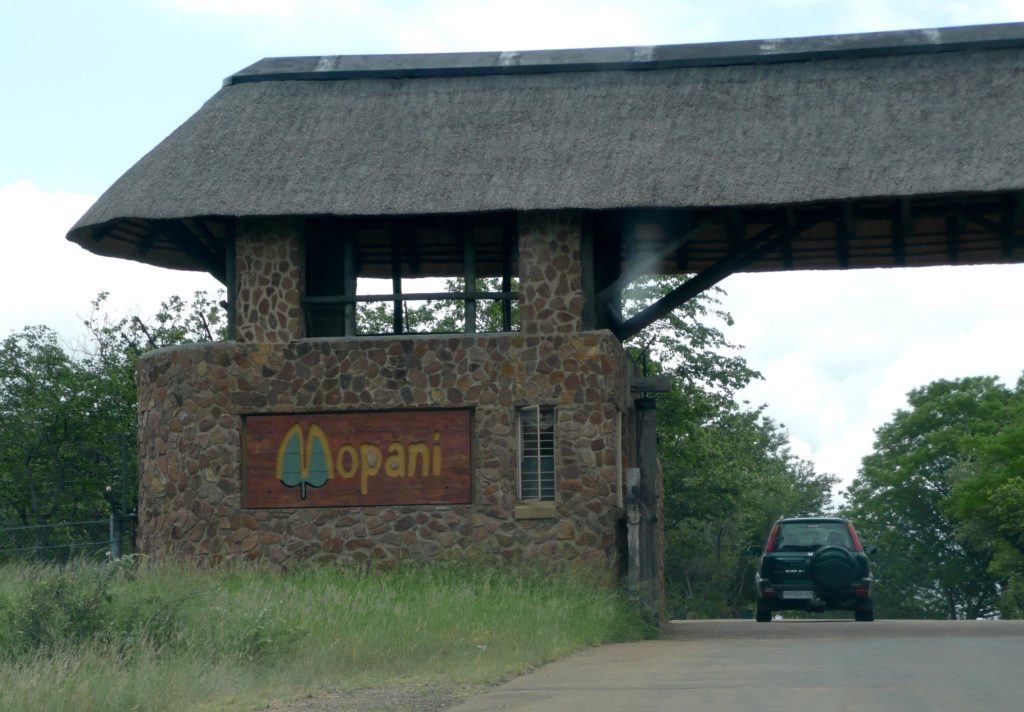
We had lunch at Mopani 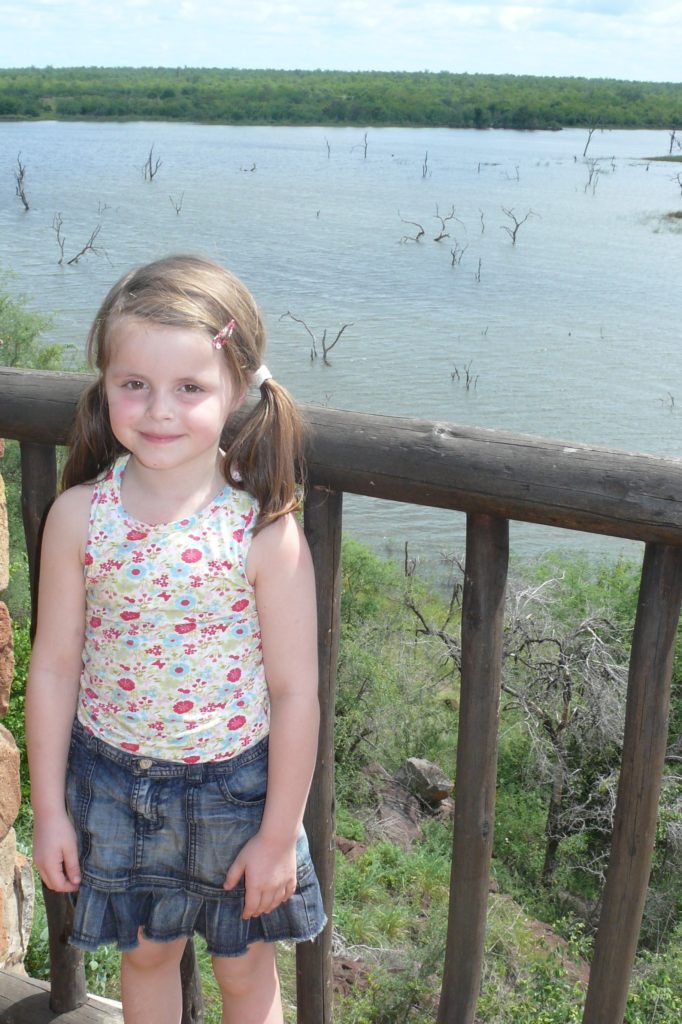
Great view of the Dam-from the restaurant 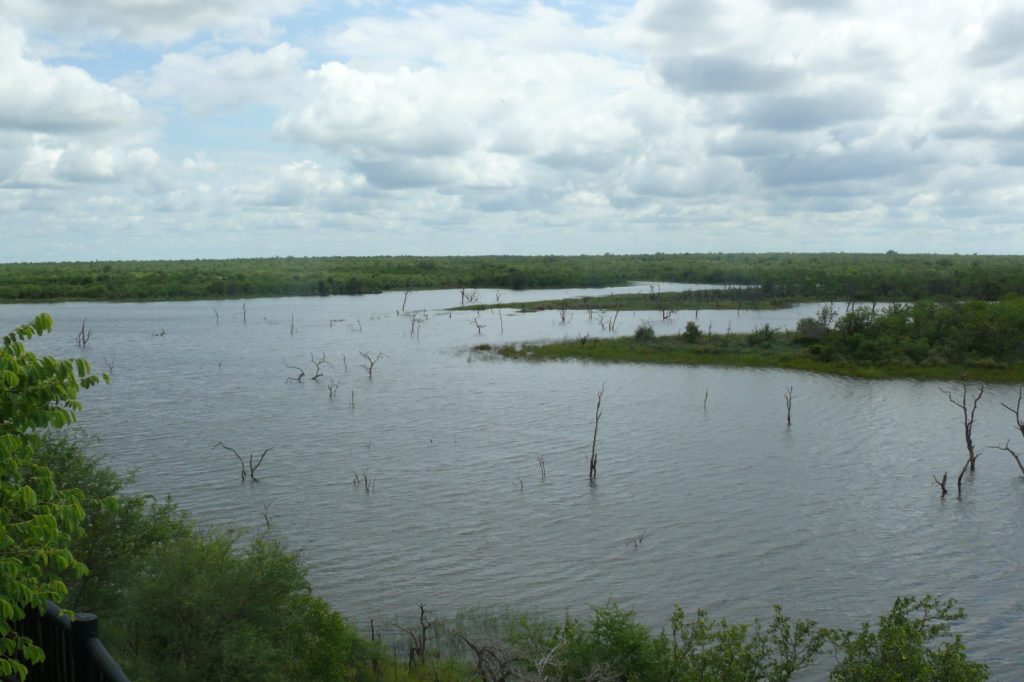

(Photo from :krugerpark.co.za)
The area is rich in plant species like the mopane shrub, red bushwillow trees and sweet grass, providing rich grazing for impala, warthog, elephant and buffalo. This is also the area for rare antelopes, and roan antelope, tsessebe and sable antelope are often seen. There is also chance to see caracal and black-backed jackal .
Big5: In addition to elephant and buffalo that are common, leopard is also seen often. But lion and rhino are seldom spotted in the area.
CENTRAL REGION
The central part – from Sabie River in the south to Letaba River in the north – is dominated by grassland and lightly wooded savanna, though there are also extensive tracts of mixed acacia woodland in the north.
It is a game-rich region and have all the big 5.
Maincamps in this area: Letaba and Olifants in the north, and Satara in the heart of the central plains. Orphen Camp – situated centrally on the western border is also considered a main camp – but is a smaller camp with no restaurant.
There are also satellite camps – Balule, Maroela and Tamboti – these have basic of facilities and no electricity. Maroela is a caravan Camp and Tamboti is tented camp. These two are near Orphen.
LETABA AND THE SURROUNDINGS
Letaba Camp – is situated on a sweeping bend of the Letaba River, midway between the southern and northern boundaries of the Kruger National Park.
Letaba means “river of sand”, and the sandy riverbed is an excellent location for game viewing, particularly elephant, which thrive in the area. Letaba is a green oasis surrounded by mopane.
Camp facilities include: cafeteria, fence perimeter, laundry, restaurant and a swimming pool.
We stayed one night in this camp – at one of the biggest bungalows : “Fish Eagle Guest House” – with 4 bedrooms and two bathrooms, big kitchen and livingroom. Close to the river there was a bird-hide/lookout, lovely positoned by the Letaba River.
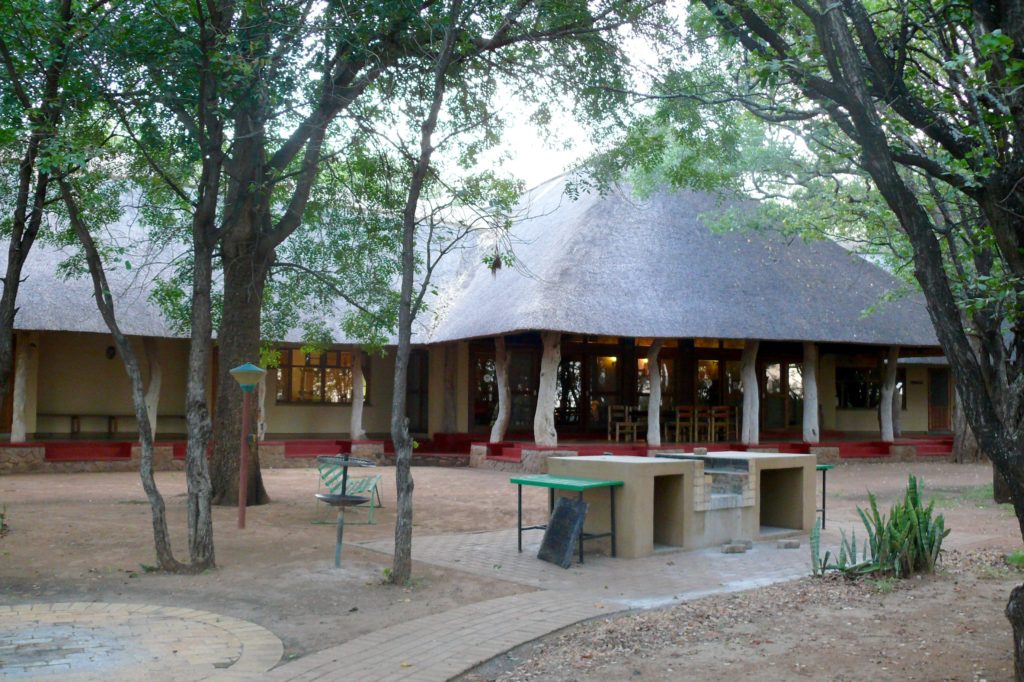
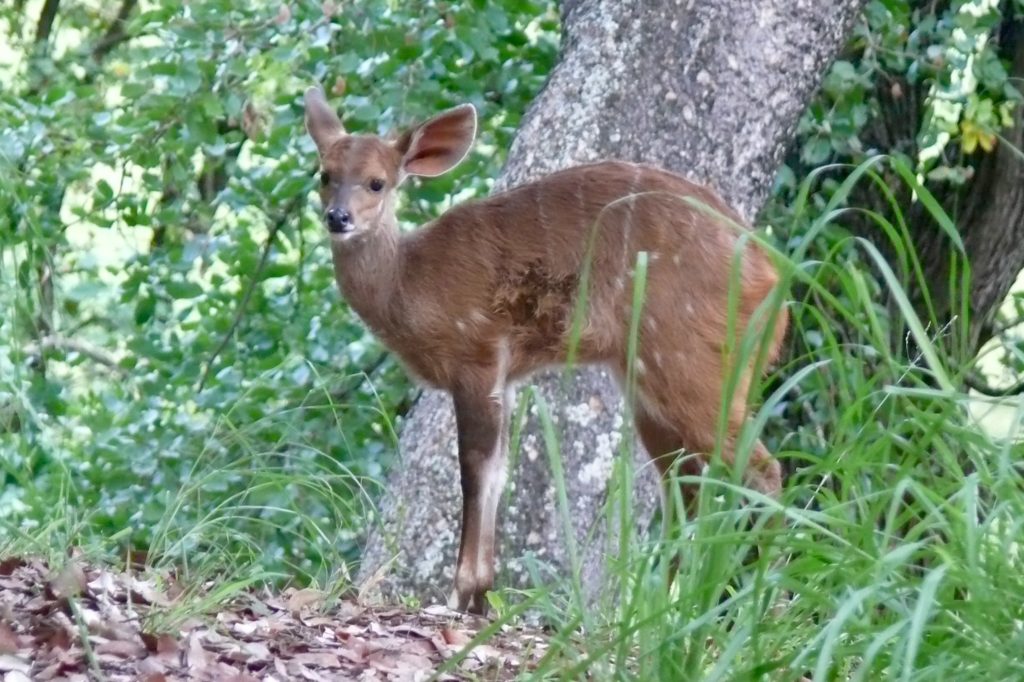
A little bush buck outside our bungalow 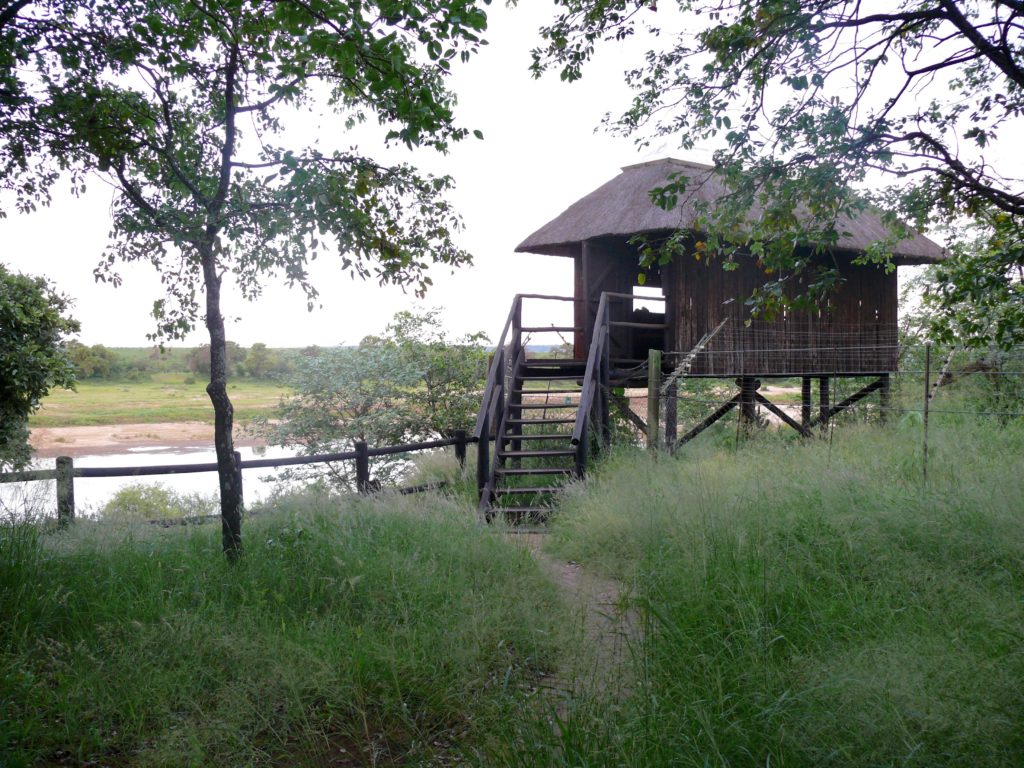
General game such as kudu, impala, waterbuck and bush buck are common in the area. It is also good for birding, many different species.
Big5– both lion and leopard are regularly seen in this area, and large numbers of elephants and buffalos. Rhino however can be difficult to spot.
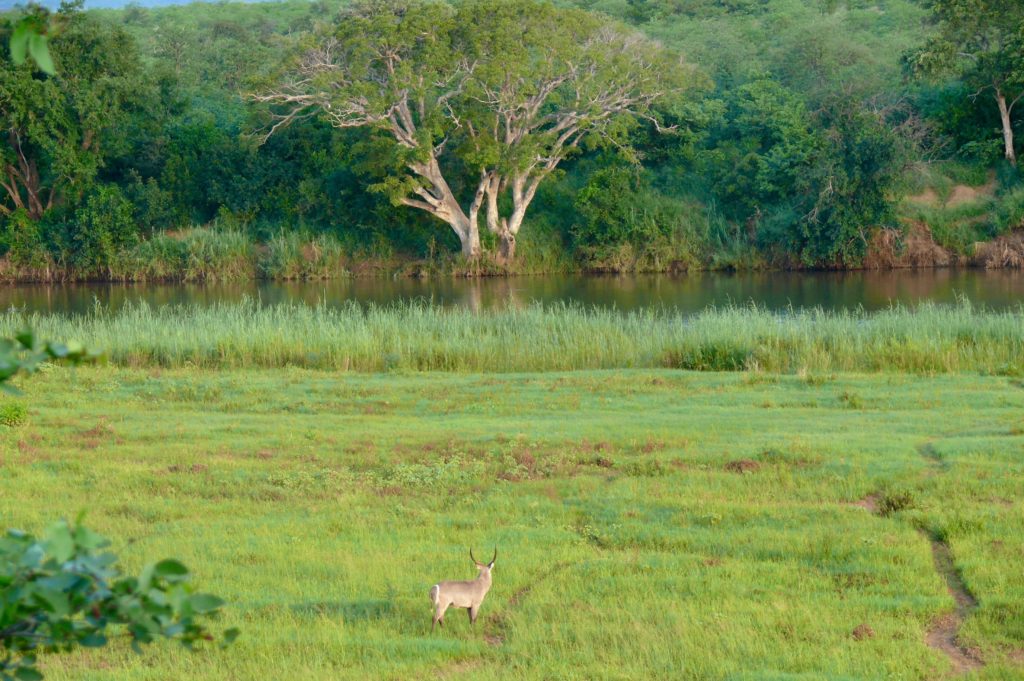
OLIFANT AND SURROUNDINGS
Olifant Camp – has a scenic location – situated on top of a hill, overlooking the Olifants river. It is one of the smallest camps but very popular. We stayed one night in this camp in 2013.
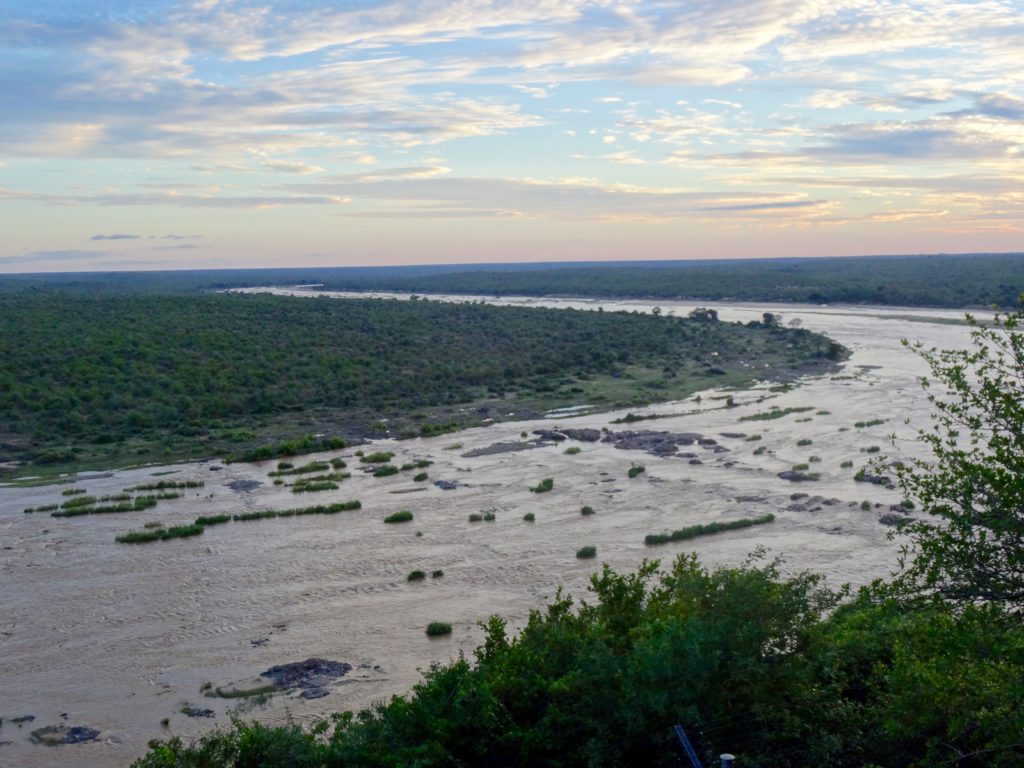
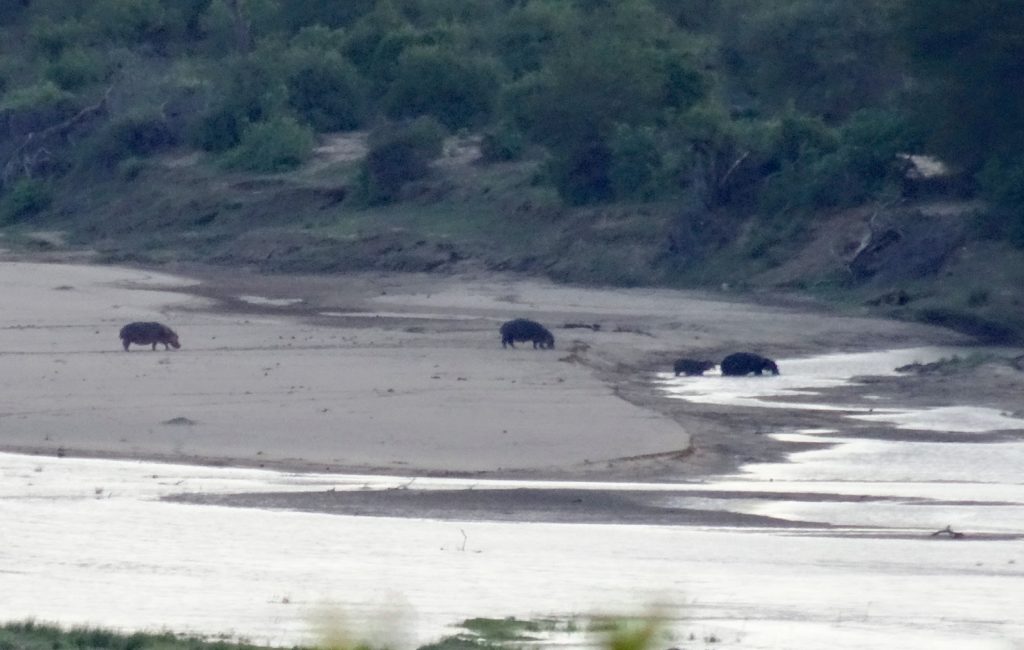
Both hippos and large crocodiles are usually visible in the pools, and also a range of other animals drinking at the riverbank; elephant, waterbuck, kudu and impala.
Big5: It is possible to spot all big five in the area. Elephant and buffalo are common. Lion are common south of the camp, and leopard are often seen in the densely wooded river valley. Rhino is more more difficult to spot.
The morning we left the Mopani camp, we were heading south, and first took the Olifant River loop – about 2km west on H8 and then south on the gravel road S92. They say lion and leopard are common here. We took this route the day before, but did not see any cats.. But this morning we spotted another cat..a more rare species. At first we did not see what is was – is was like a small lynx – and we found out it was a caracal !
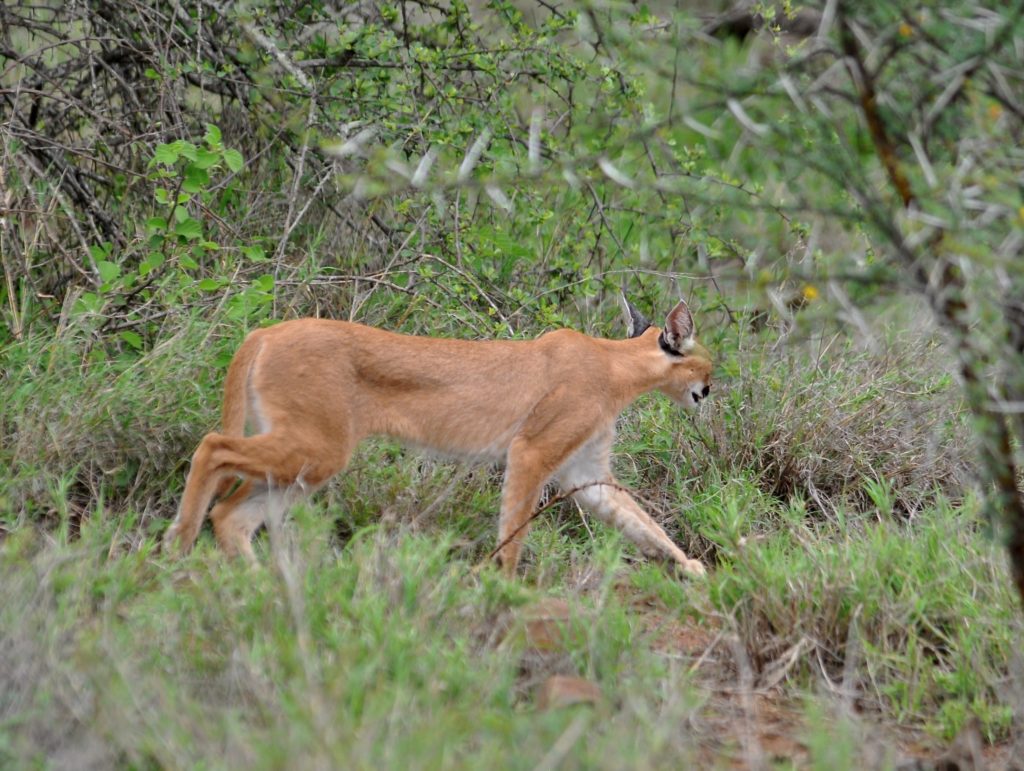
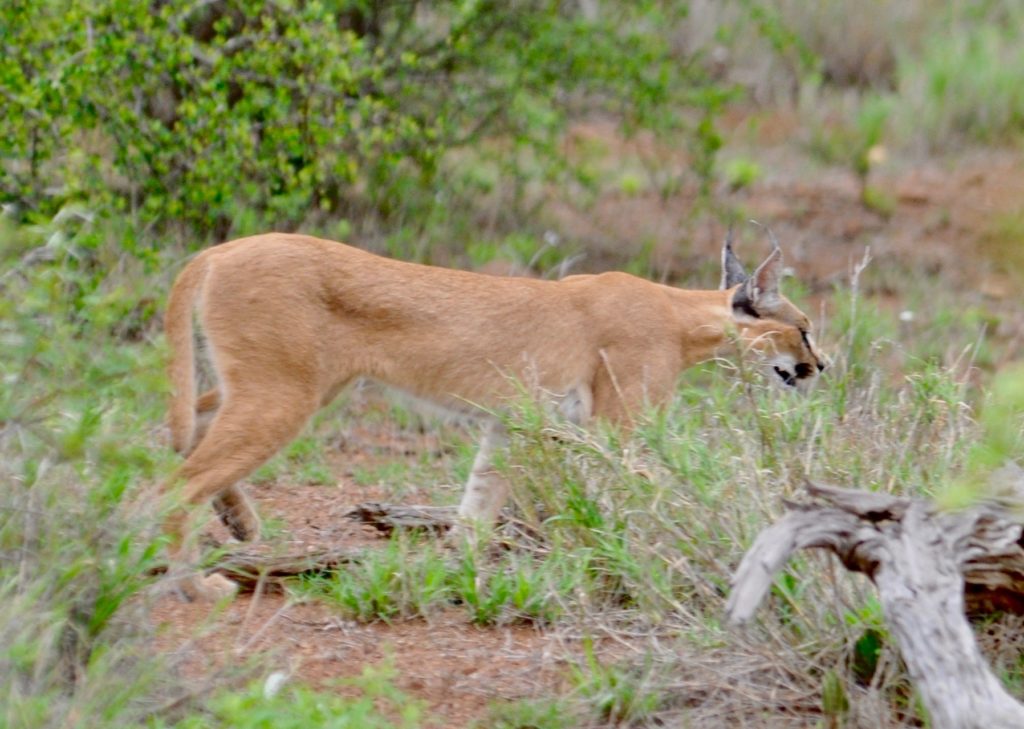
A special sight – as the caracal is predominantly nocturnal.
An elegant and beautiful cat!
Going further south of Mopani – towards Satara – you meet open grassy area frequented by herds of wildebeest, zebra and antelope and other grazers. That means there are also large predators in the region.
SATARA AND THE SURROUNDINGS
Satara Camp – is the second largest camp in Kruger – after Skukuza, and offers accommodation, restaurant, cafeteria and laundry facilities.
It is known as the “cat camp” because this is one of the best areas to spot lion, leopard and cheetah. This is also the reason for it popularity.
The rich grazing land and many waterholes here attract large numbers of antelope, zebra, wildebeest, waterbuck and buffalo – with the big cats close by.
Big5: Although rhino is not easily spotted, all the other four occur in large numbers, espescially lion.
Lions are inevitably followed by scavengers, and this area also contains large numbers of spotted hyaena, black-backed jackal and vultures.
Our sights in the area:
Along the gravel road S100 – eastwards from Satara – we spotted many giraffes, zebras, waterbucks and beautiful birds.
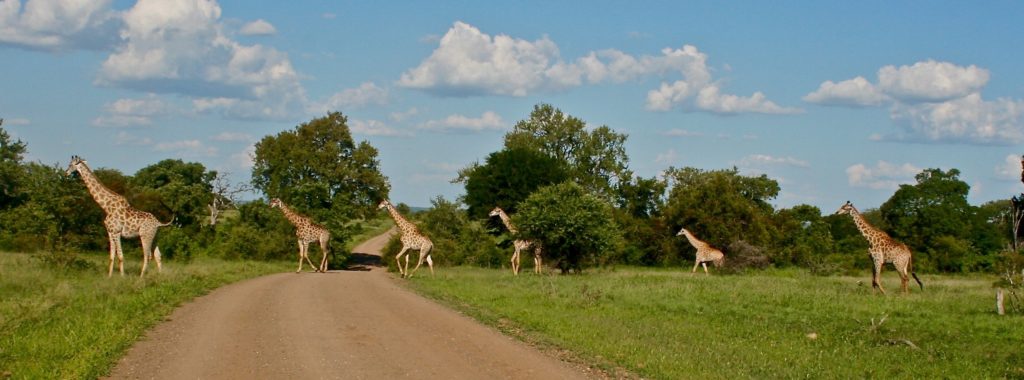
West of Satara, in the beginning of the tar road H7 that goes to ORPEN, we saw zebras, wildebeest, eagles and vultures.
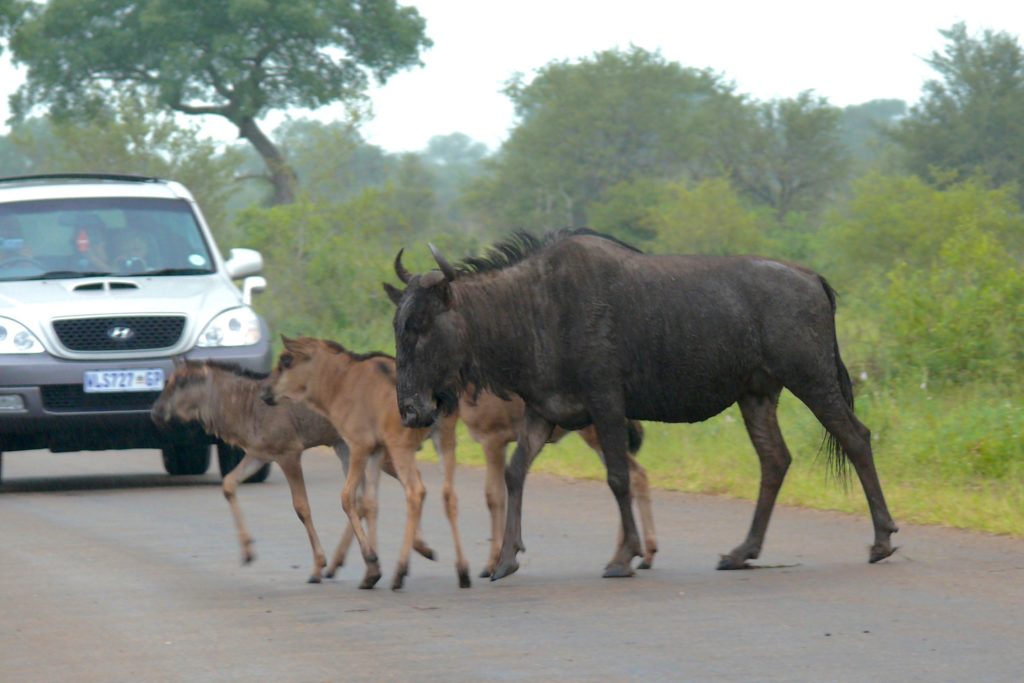
The best cat sights though (2010) – we had around the H7, closer to Orpen Camp. Just a couple of km before we came to Orpen Camp, many cars had stopped at one side of the road – which means there might be an interesting sight close to the road. And this time is was this lovely cat:
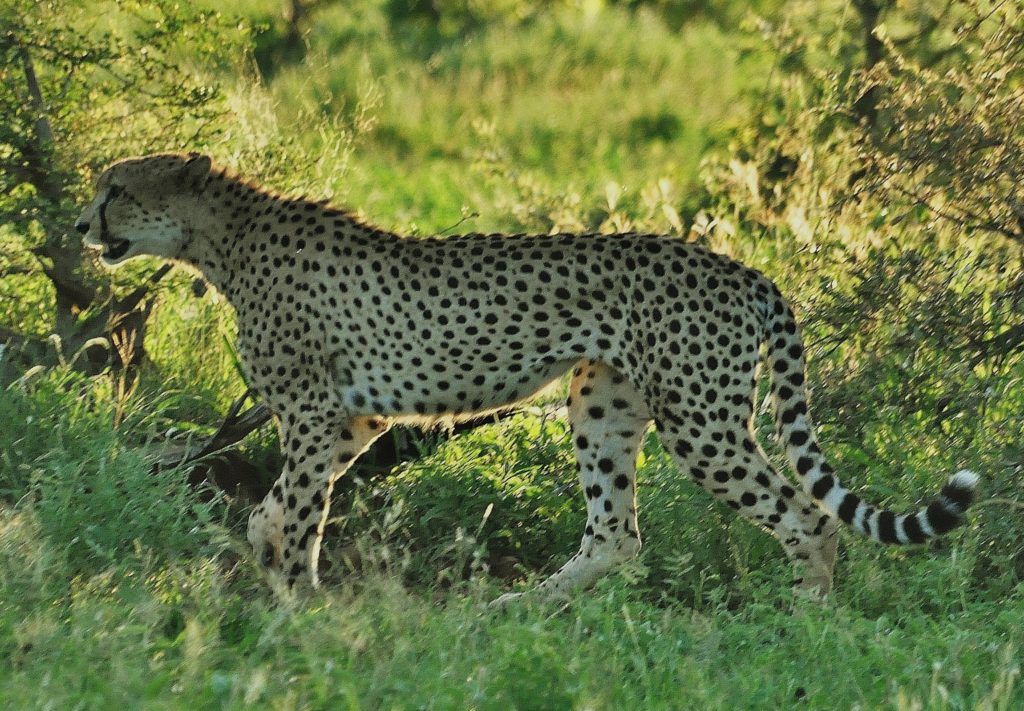
This was an evening at the end of December 2010. It was true that it was a good area to see cheetah!
The evening, the next day – same road – a lot of cars again. This time – lions – – this lovely couple in the bushes:
The same day – same road – wild dogs:
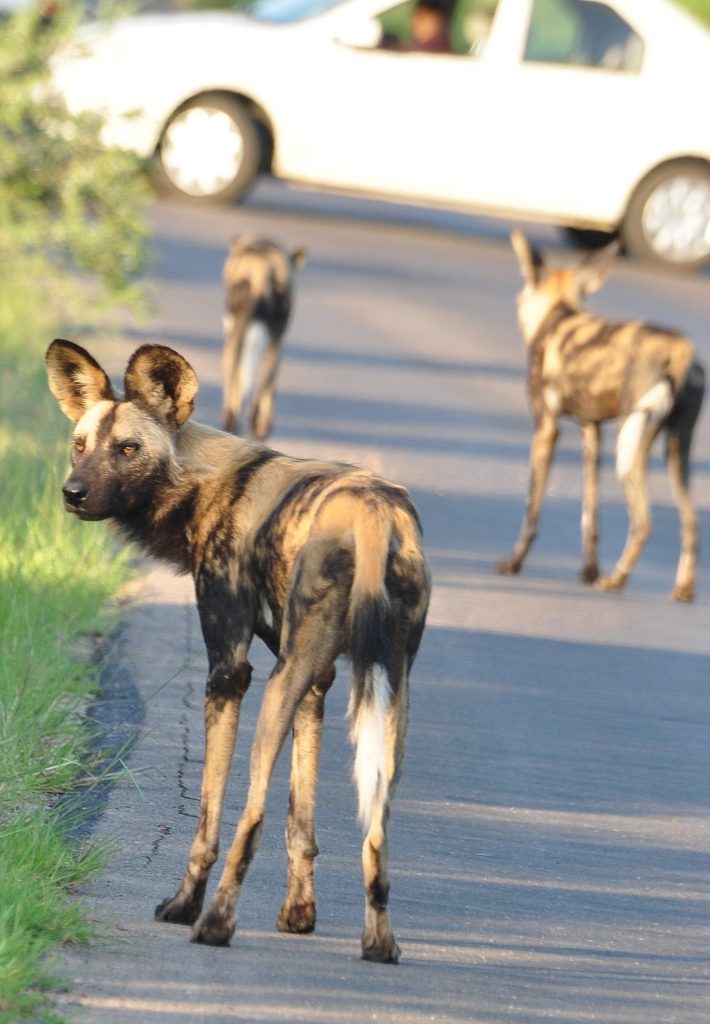
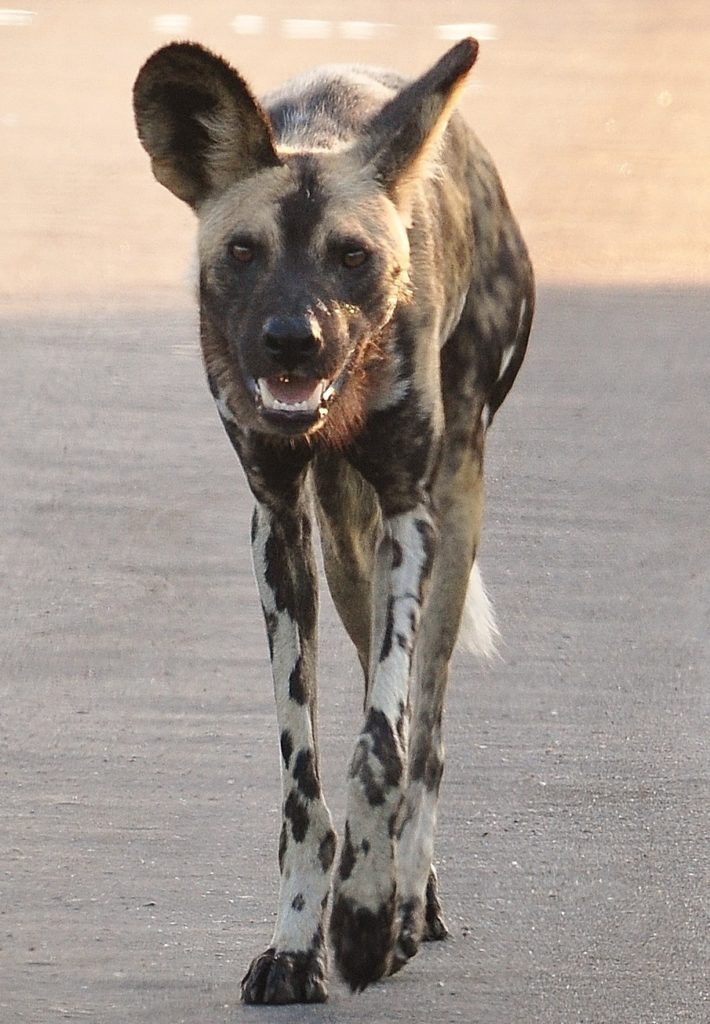
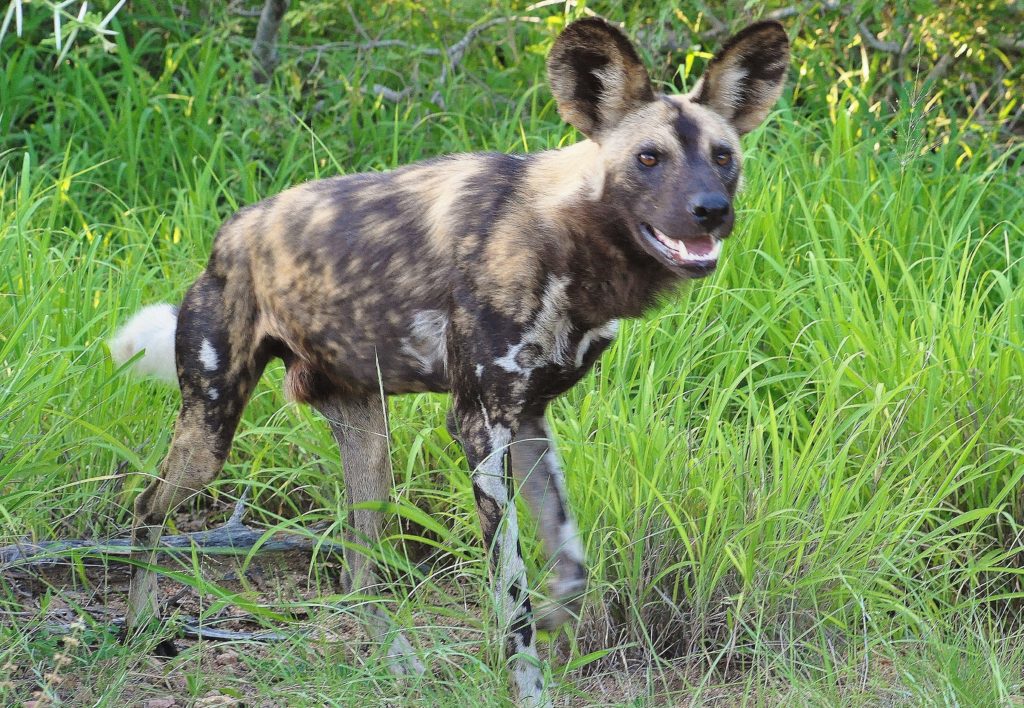
Wild dogs
SOUTHERN REGION

The southern region – from Sabie River in the north to Crocodile River in the south – has the greatest concentration of game – and gives very good opportunities to see the Big5 and plenty of others animals. That is why this part attracts most visitors and is the busiest part in the Kruger. If you are coming from Johannesburg or south of the country this region is also the closest part to enter the Kruger.
These are the gates of the southern region:
- Paul Kruger Gate
- Phabeni Gate
- Numbi Gate
- Malelane Gate
- Crocodile Bridge Gate
The main camps in the south:
- Skukuza
- Lower Sabie
- Crocodile Bridge
- Berg-en-Dal
- Pretoriuskop
OTHER CAMPS
Bush camp :Biyamiti
Satellite camp :Malelane
SKUKUZA AND SURROUNDINGS
Skukuza Camp: Located in the north of the southern region – and serves as the Headquarter of Kruger National Park. Skukuza is located 20 minutes from the Paul Kruger Gate and is the biggest camp in the Kruger. It offers a gas station, library, post office, car rental, grocery store, 9 hole golf course and swimming pool.
Skukuza is situated directly at the Sabie River and animals like elephants, hippo, crocodile, giraffe and waterbuck often come here to drink.
We have stayed at this camp several times, and the last time we spotted a leopard by the river. We could see it from the restaurant area. Have also seen hippo, crocodile, elephant and waterbuck by the riverbanks.
There are also a lot of different bird species in the camp area. These beautiful sunbirds (hummingbirds) were right outside the reception in Skukuza
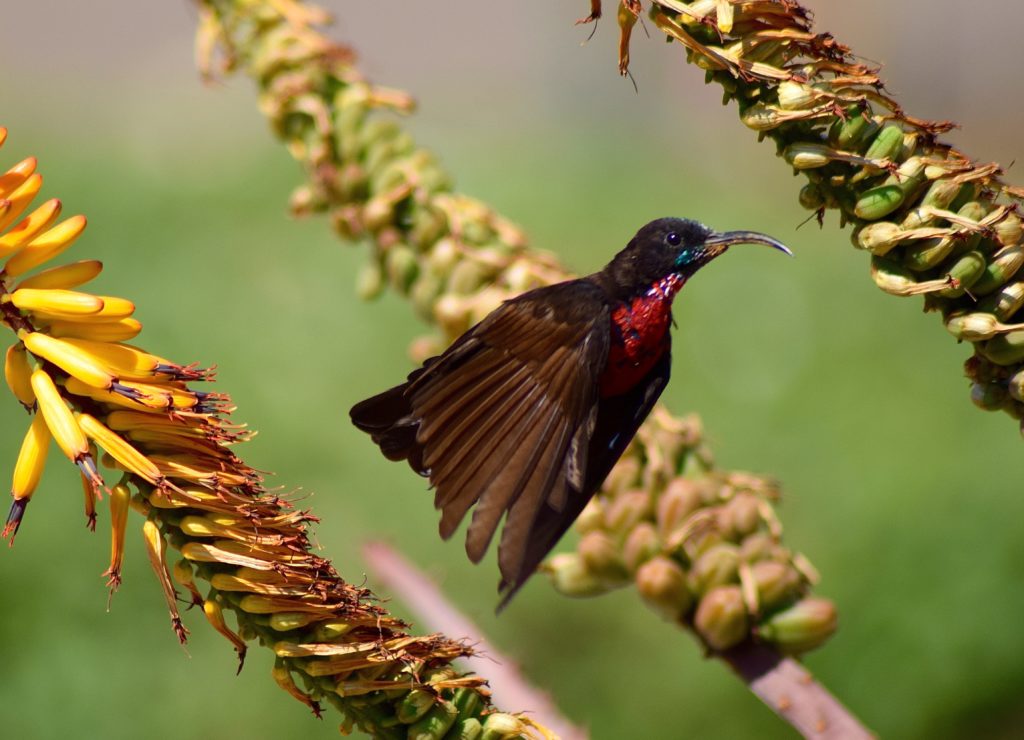
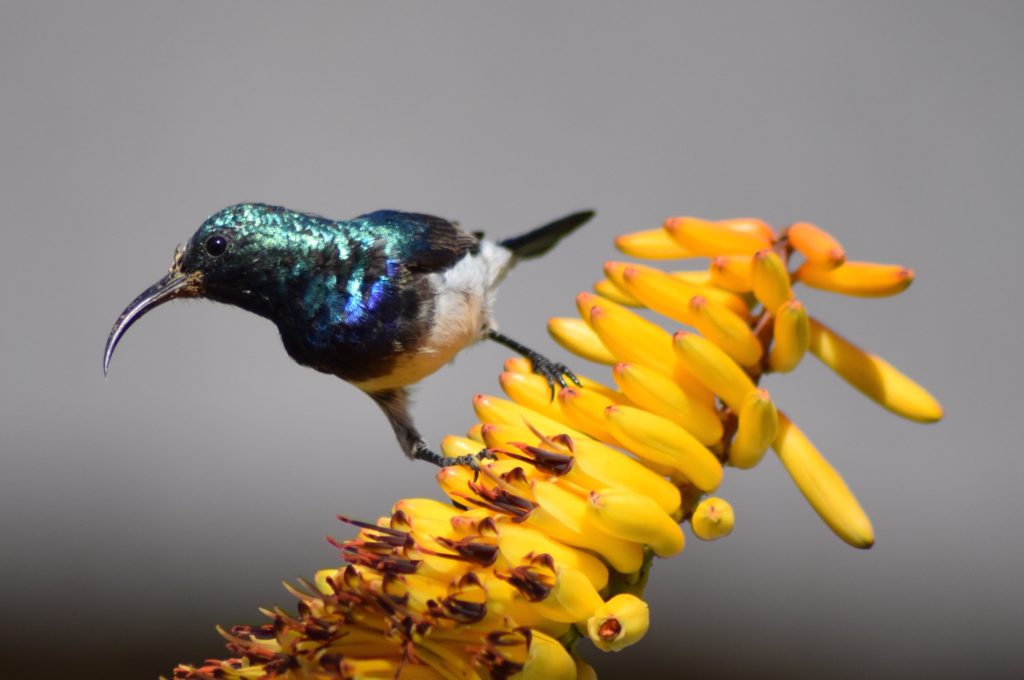
The areas around Skukuza are the best game viewing areas in the park. Especially near the Sabie river.
Big5: Lions are seen frequently, while leopard are seen every day along the densely vegetated river margins. Both elephant and buffalo are abundant in he Sabie River. Rhino occur in the area but is not so easily spotted.
Some of our sights in the area:
We have seen lions at several occasions around Skukuza. Both south of Skukuza and by the Sabie River. In 2017, we met this big male lion – crossing the bridge over Sabie river with a lot of cars following. We came from the north side of the river and it came straight towards us:
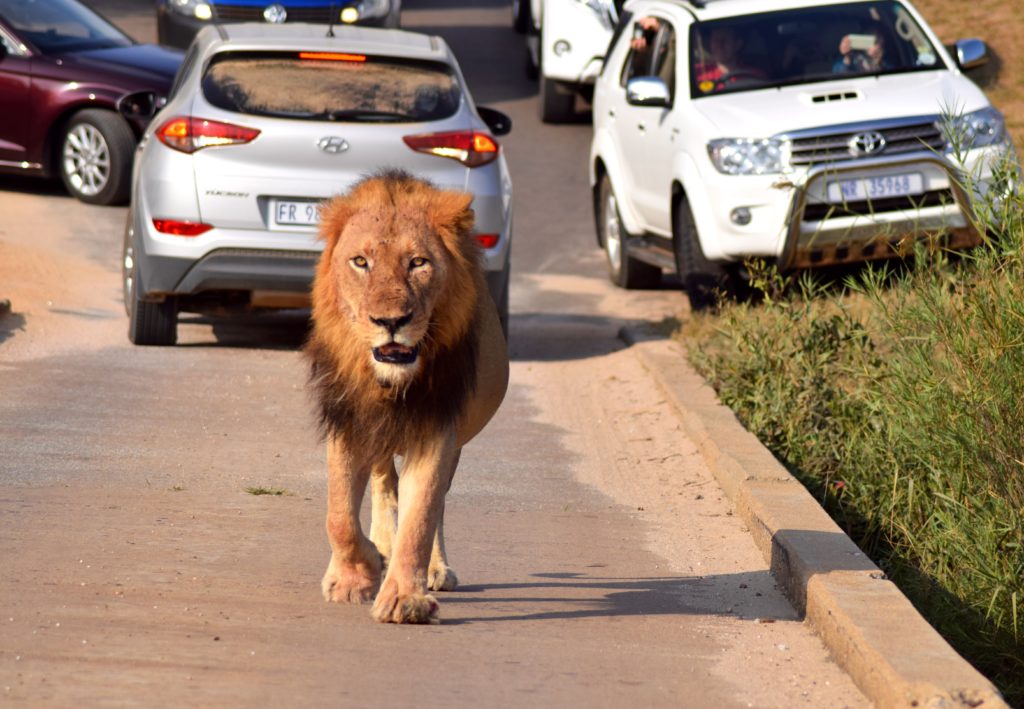
We have also spotted leopard, just north of Sabie River, at the riverbanks of Sand River, north at route S83.
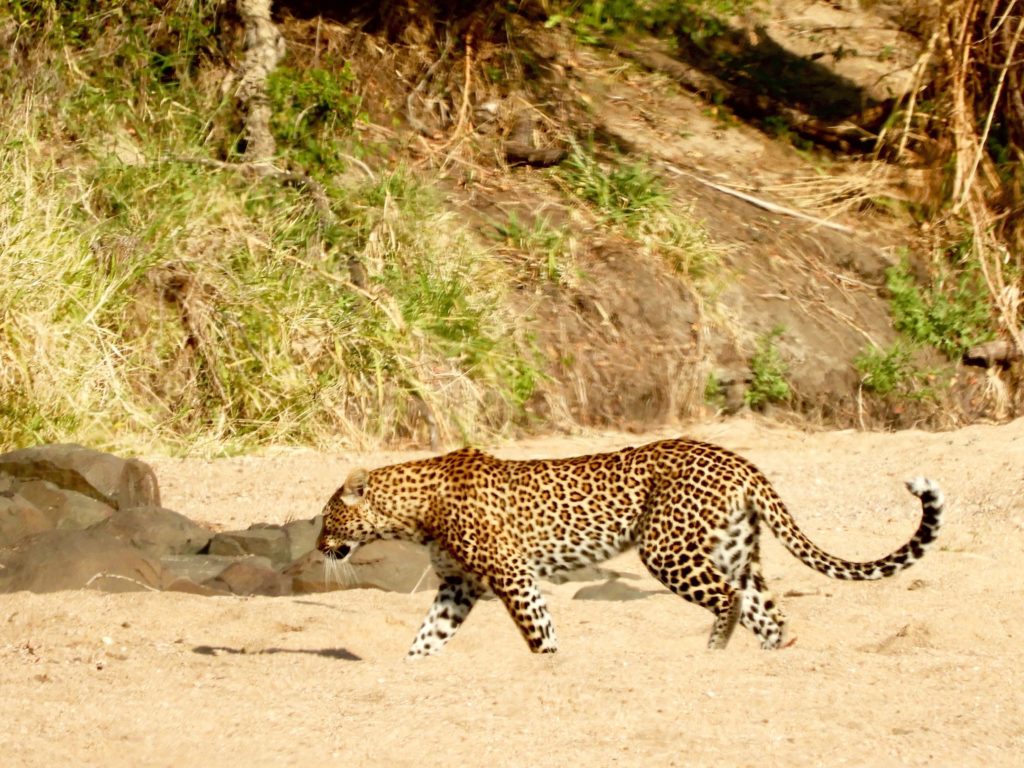
We spotted this leopard first at the dry riverbanks of Sand River. We were the only car in the area at that time. We drove a little bit further, and waited. – As we hoped – the leopard came through the bushes and crossed the road just in front of us. An extraordinary experience.
The road H4-1 – going east towards Lower Sabie, is a busy route – but for a reason. You are almost guaranteed some great sightings. Baboons and monkey are common along the route, as well as large numbers of impala.
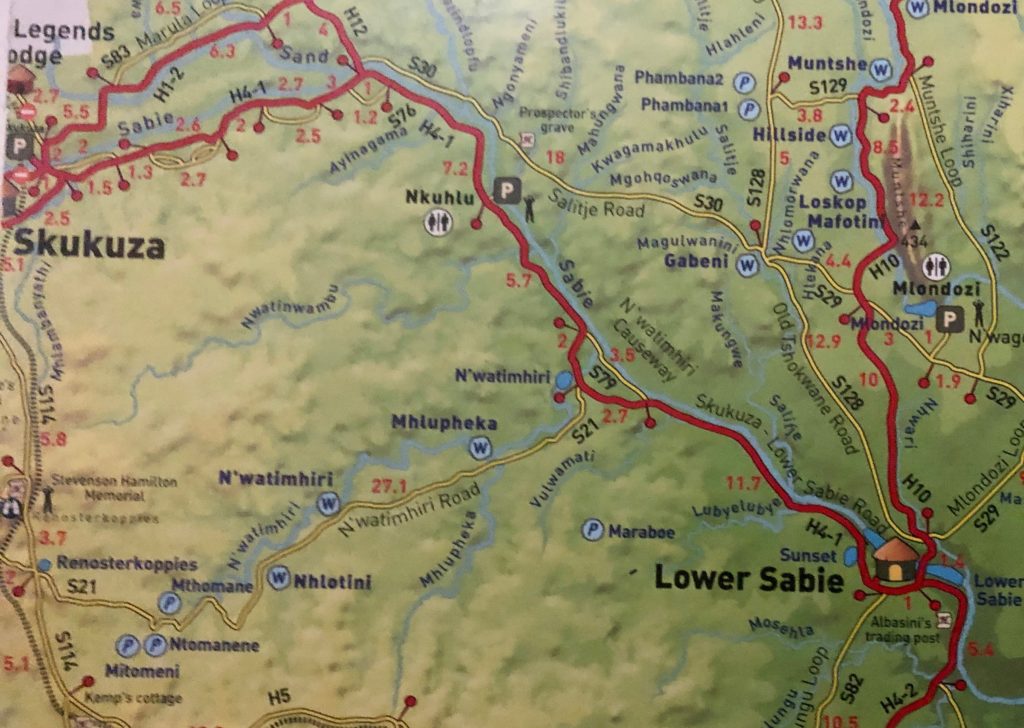
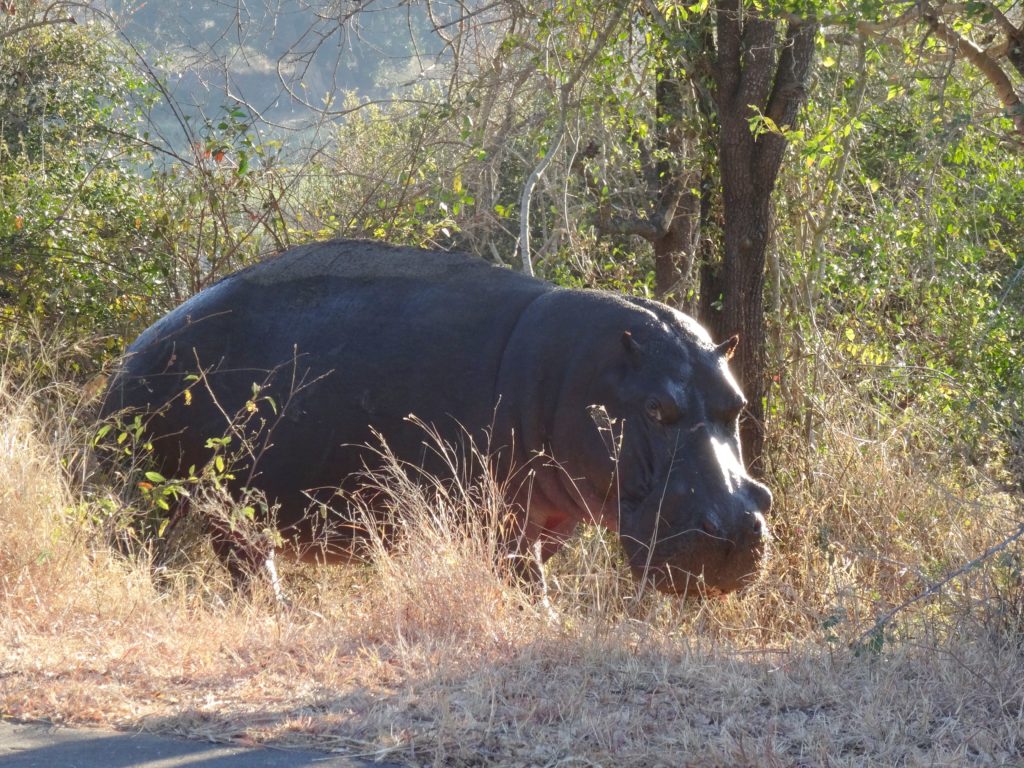
We have seen lion several times, and elephants and hippo by the river. In the winter time is common to see hippos and crocodiles out of water, catching the sun on the sandbanks. One chilly morning in July we met this hippo right by the road.
LOWER SABIE AND SURROUNDINGS
Lower Sabie Camp – is a large camp with a wonderful location on the banks of Sabie River. It is undoubtedly one of the most popular camps in the park – and with good reason. The wildlife here is prolific and it is an excellent spot to see the Big 5!
The large sycamore figs, sausage trees, fever trees and jackal berries lining the Sabie river give the camp a shady, relaxed feel and attract a wide range of birdlife. Elephant, hippo, buffalo and other game congregate at the river to drink and are easily viewed from the camp.
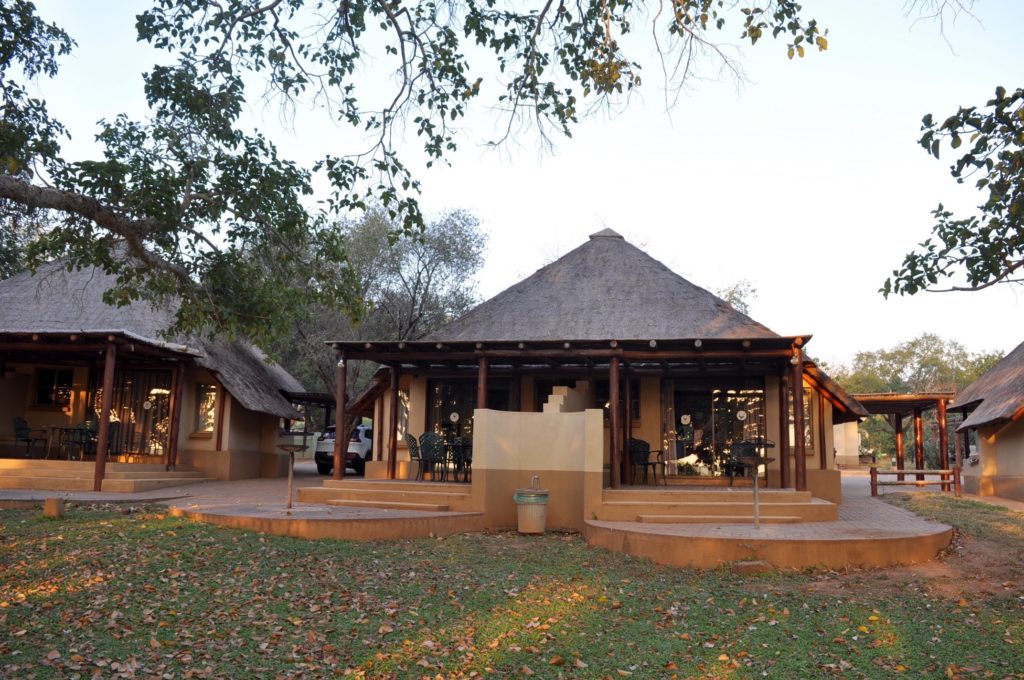
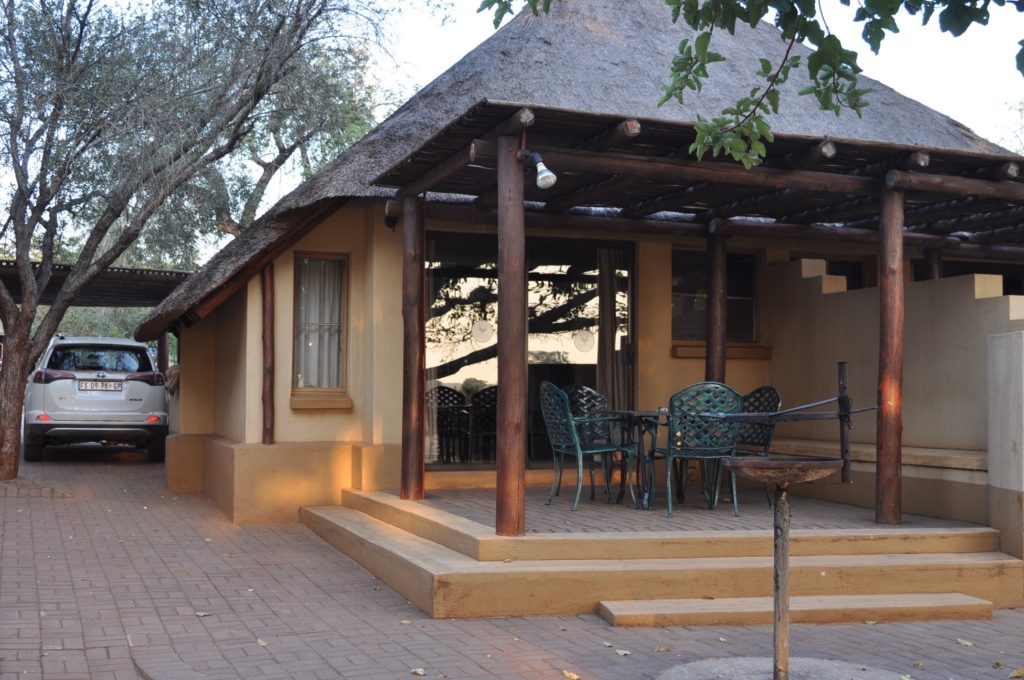
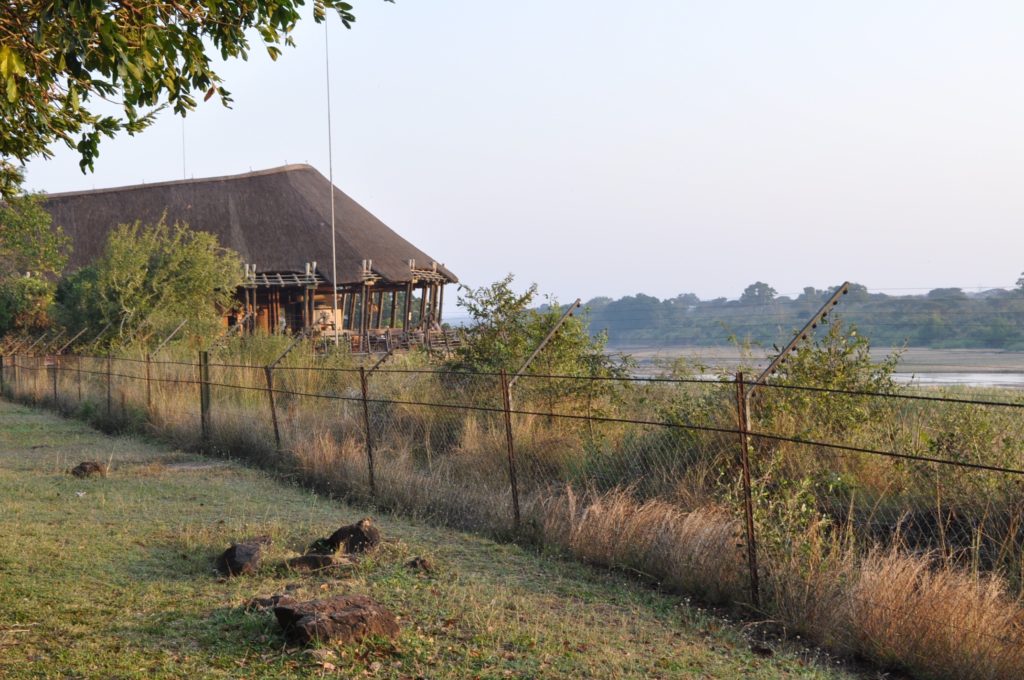
View of the restaurant and river.. 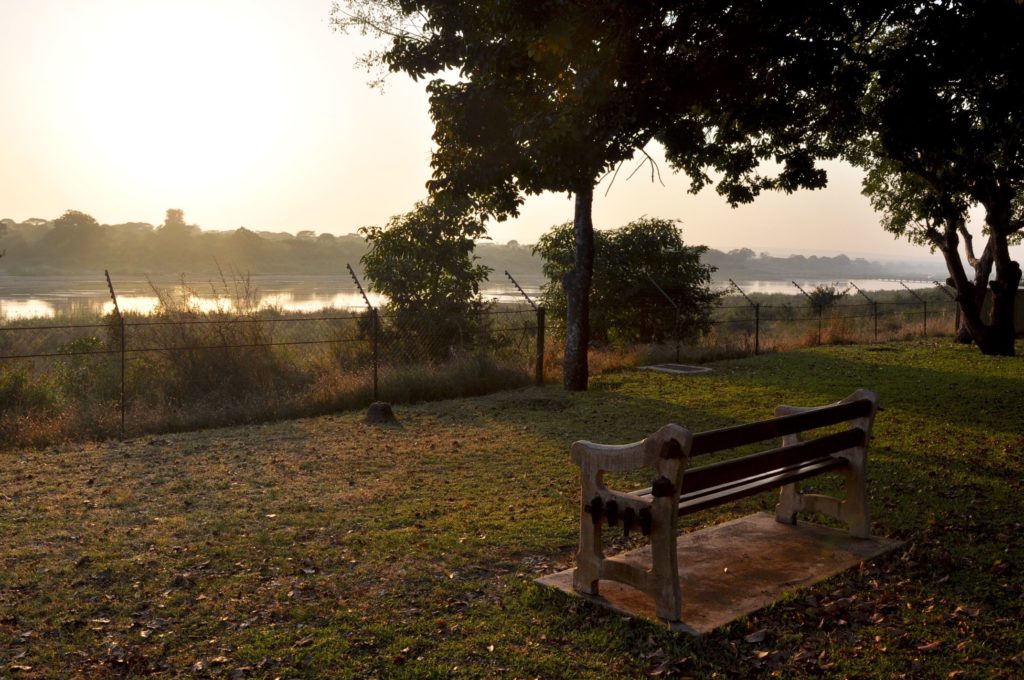
Surroundings – there are a wide range of animals in the area. At the Sunset Dam just 1 km north of the camp – there are often big crocodiles and many hippos.
The area is also good for wild dogs, lion, leopard, rhino and giraffe.
BIG5: All the members are present in the area! We have seen all of them in the surroundings – but maybe not all at the same stay.
Some of our sights in the area:
At Sunset Dam we have seen big crocodiles and hippos lying in the sun -sometimes side by side. Especially in wintertime, when the days are cooler, it is more common to see crocodiles and hippos out of water, catching the sun.
South of Lower Sabie:
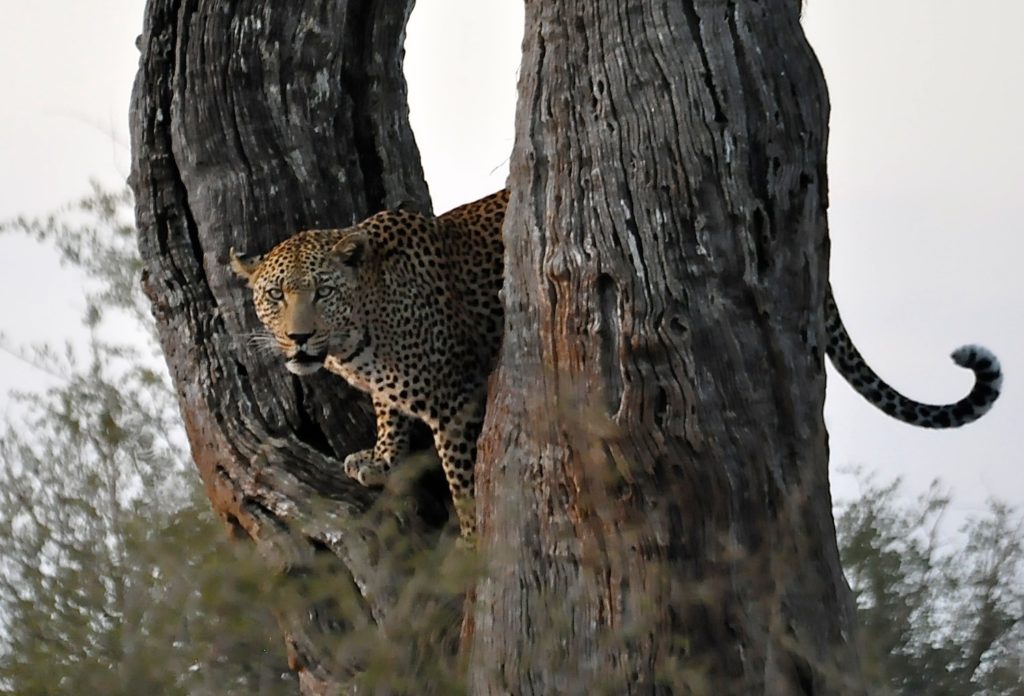
Just south of Lower Sabie, at the gravel road S137, we had our first sight of a leopard in a tree with a prey. The leopard was on the ground when we came driving, we stopped and watched together with several other cars. The prey, an impala, was already dragged into the fork of a tree several meters off the ground. A hyena was sneaking up on, trying to get some of the prey, but was chased away by the leopard. The leopard then jumped up into the tree and enjoyed its prey.
CROCODILE BRIDGE AND SURROUNDINGS
Crocodile Bridge camp is a small gate camp 10 km from Komatieport. The camp is situated in the south – southeast of the park, on the banks of the Crocodile River overlooking the old railway bridge – from whence it gets is name.
It is surrounded by some of the best game viewing areas in the Park. The sweet grass plains in Crocodile river area attracts a variety of both grazers and browsers, with predators close by. It is also good country for cheetah, and wild dogs are commonly seen, as well of rarer buck species such as reedbuck and nyala.
Big5: Both black and white rhino are common, while elephant and lion are regularly seen on S25 west. At this route, around midway to Malelane Gate, in year 2000 we saw 9 female lions, one by one marching out from the bushes. We waited until each one passed the car, taking a lot of photos and video, a very exciting moment. Just after leaving these 9, two male lions were lying close to the road, WOW that was awesome! I am going to digitalize these analogue photos and present them on this web site.
In 2014 my daughter and I also saw 6 female lions just at the beginning of this route S25, not far from Crocodile Bridge camp:
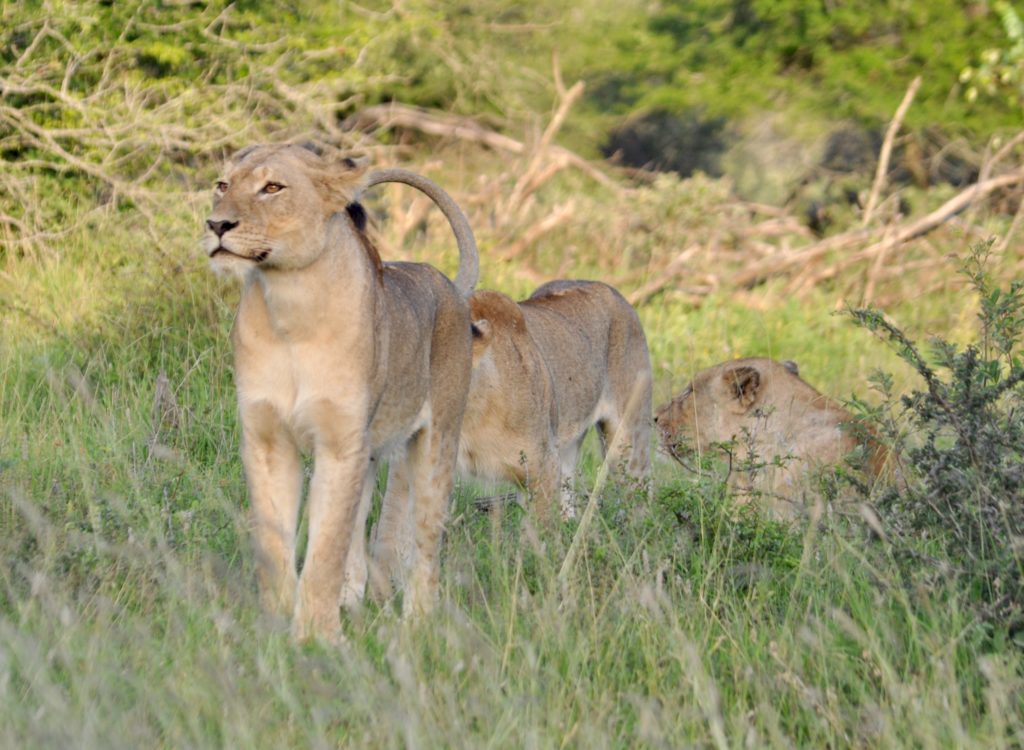
We have also seen large numbers of buffalo in this area, both at route S25 and at the beginning of S28 just north of the camp.
BERG-EN-DAL AND SURROUNDINGS
Berg-en-Dal Camp is a large, modern camp, set amongst Rocky Mountains and overlooking the Berg-en-Dal Dam. Its facebrick bungalows are ideal for families. The camp has a modern restaurant and shopping complex and a fantastic swimming pool.
The dam near the reception is home to hippo and crocodile, and elephant, bushbuck and waterbuck are also often seen drinking from the dam.
The surrounding area is excellent for Rhino. Leopard are commonly encountered near the camp, and this is also a good area to see klipspringers, mountain reedbuck and Grey Rhebuck. Kudu, giraffe and warthog are common.
Big5: Rhinos are almost guaranteed, and the probability to see leopard is good. Elephants are common and while lion may be seen on longer drives.
Buffalo not so common, but I remember to have seen some at route S120 on the way to the camp.
Some of our sight in the area:
First time we saw a leopard in a tree – an early morning at the end of December 2010. This was just by the road H3, only a couple km north of Malelane Gate/10km east of Berg-en-Dal. Fantastic experience !
Just north of Malelane Gate – Rhinos:
PRETORIUSKOP AND SURROUNDINGS
Pretoriuskop Camp at the south, south-eastern part of the park, is one of the oldest camps in the park and the first to offer visitors accommodation. These days some visitors prefer the busier camps further east which tend to offer better game viewing.
The surroundings are good for game such as kudu and waterbuck
Big5: Not a good area for lion, but they are seen occationly. Leopard, elephant, buffalo and rhino are regularly seen on drives from the camp.
Our sights in the area:
Just east of Pretoriuskop, at H1-1 , we have seen rhinos and buffaloes. Further east on H1-1, near the crossection H1-1 and H3, we have seen lions on several occasions
Like this – an early morning – a lion was walking alone – further down the road it met an elephant with baby. As the lion came closer, the elephant got a bit angry and protective, and the lion moved a bit to the side, before quietly moving on.
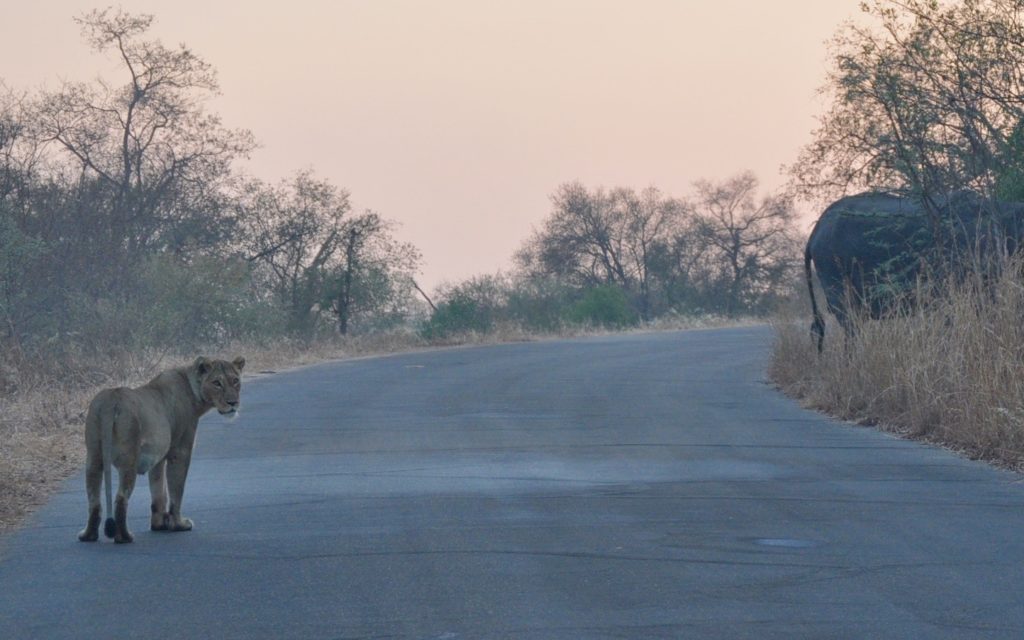
Another magical moment; It was also at H1-1 we spotted this cheetah, in the middle of the road. We were the only car there, and slowly followed it down the road, for about 5-10 min before a couple of safari vehicles came from the other direction.
A baby hyena left alone by its mother, very cute. It was a curious and hungry little fellow – came towards the car. This was also at H1-1:
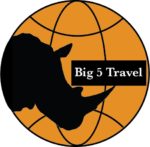
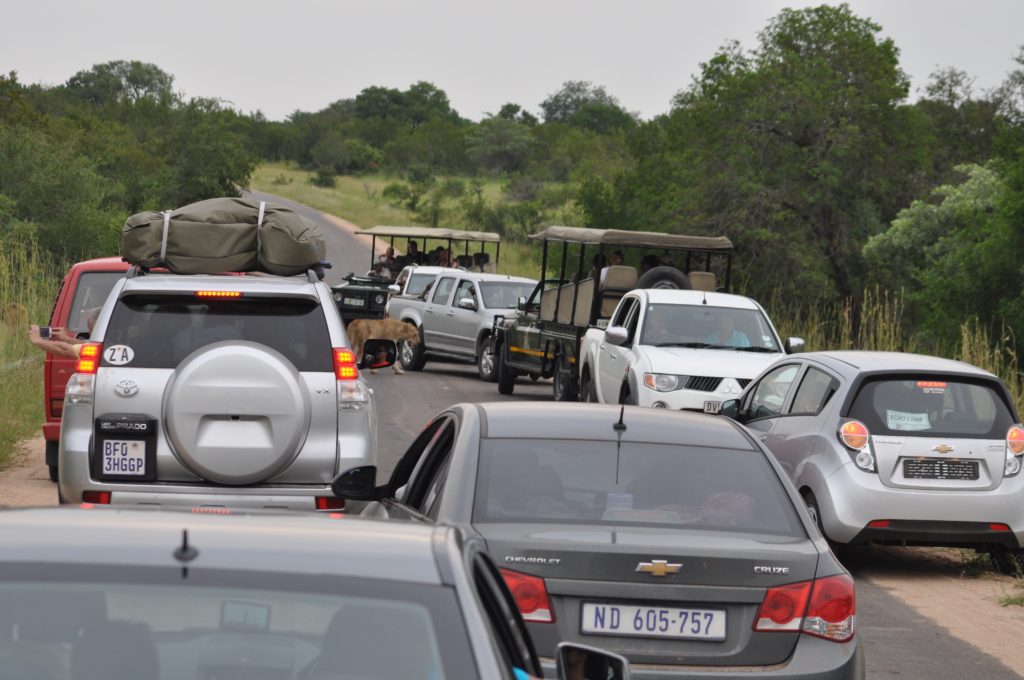
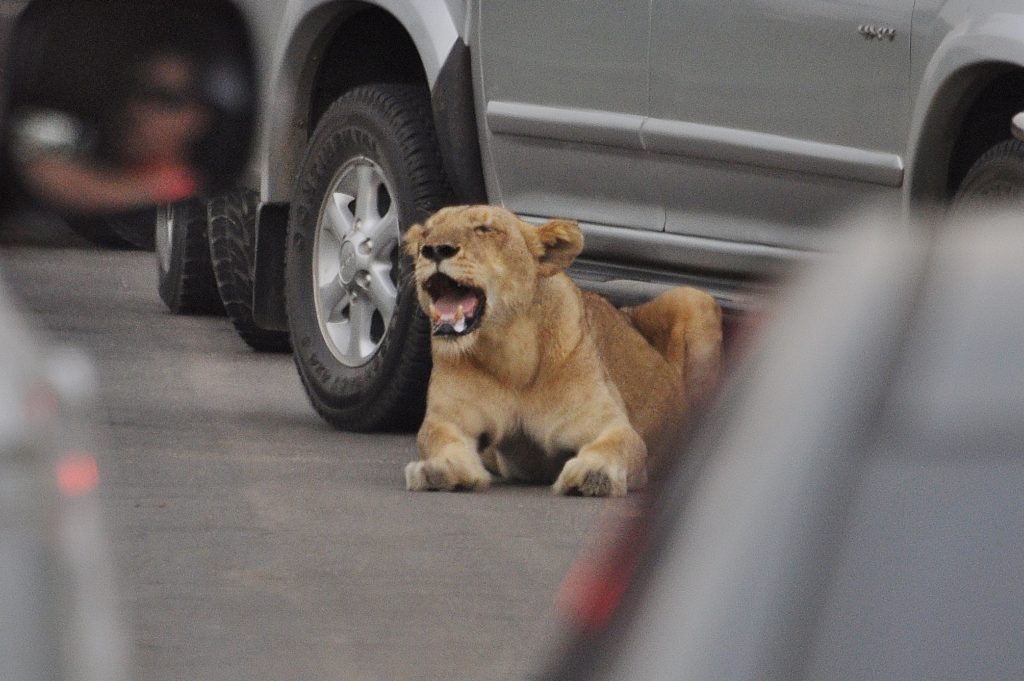






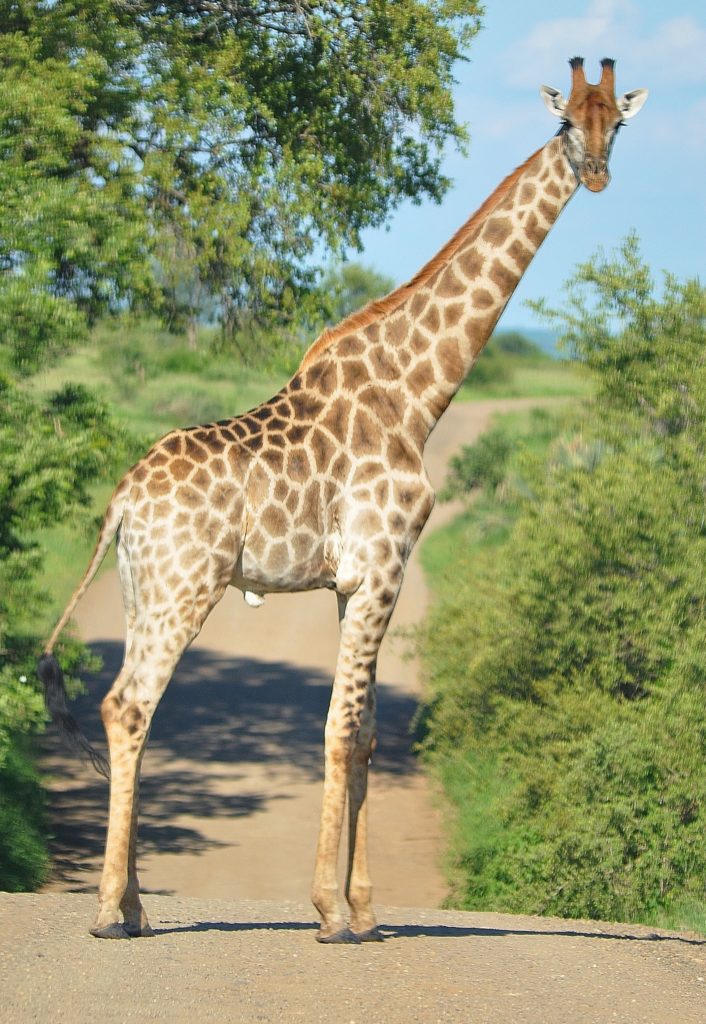
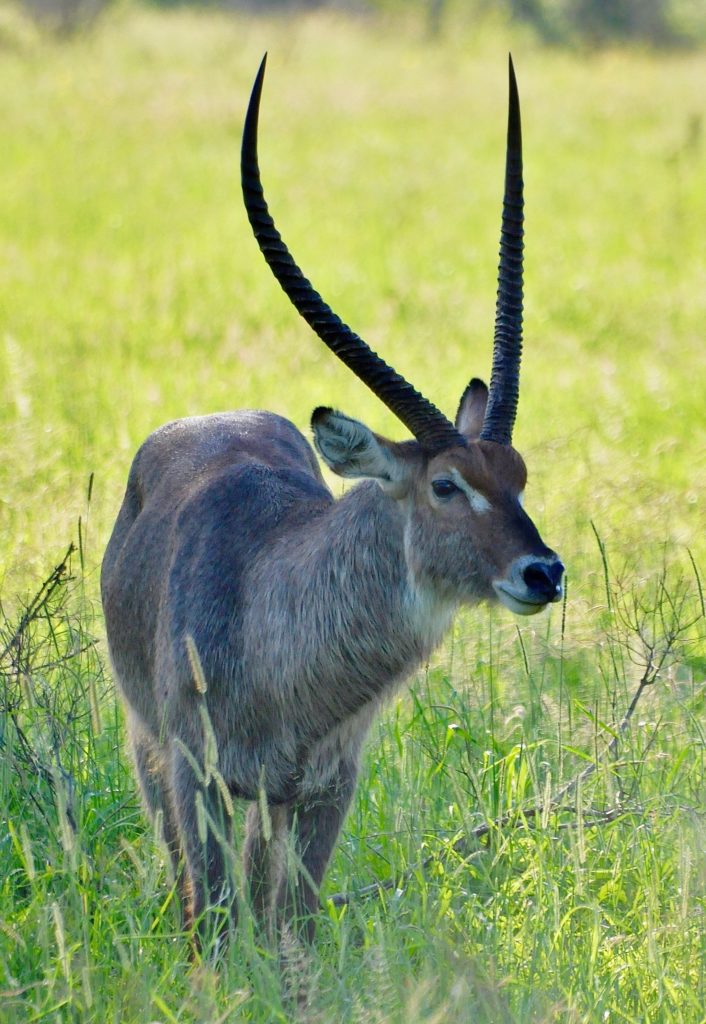
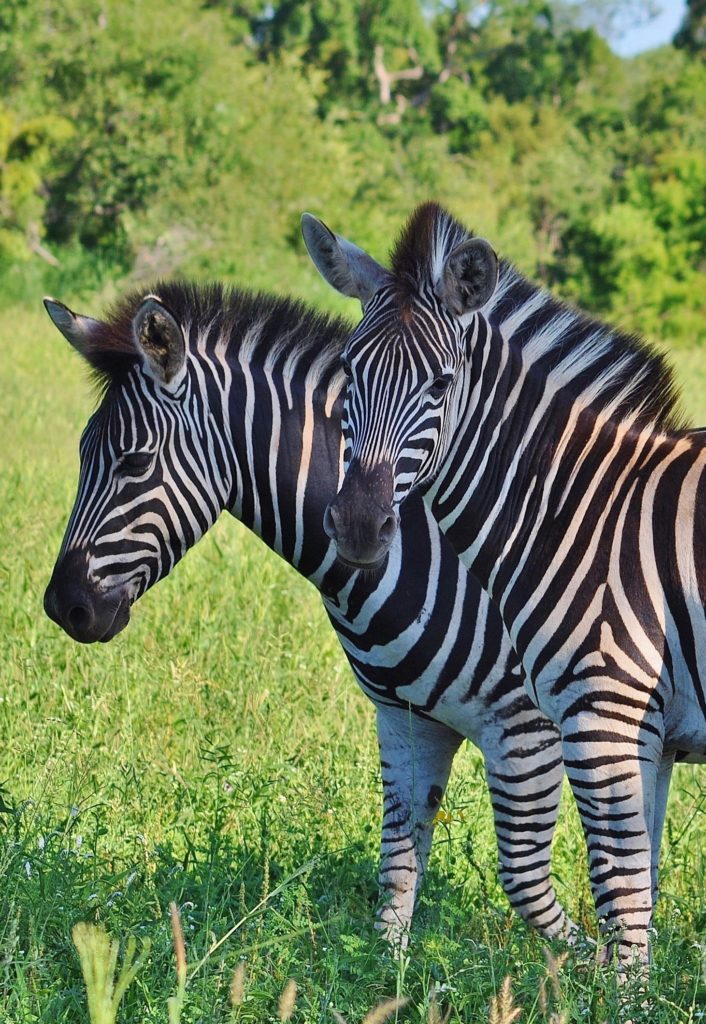
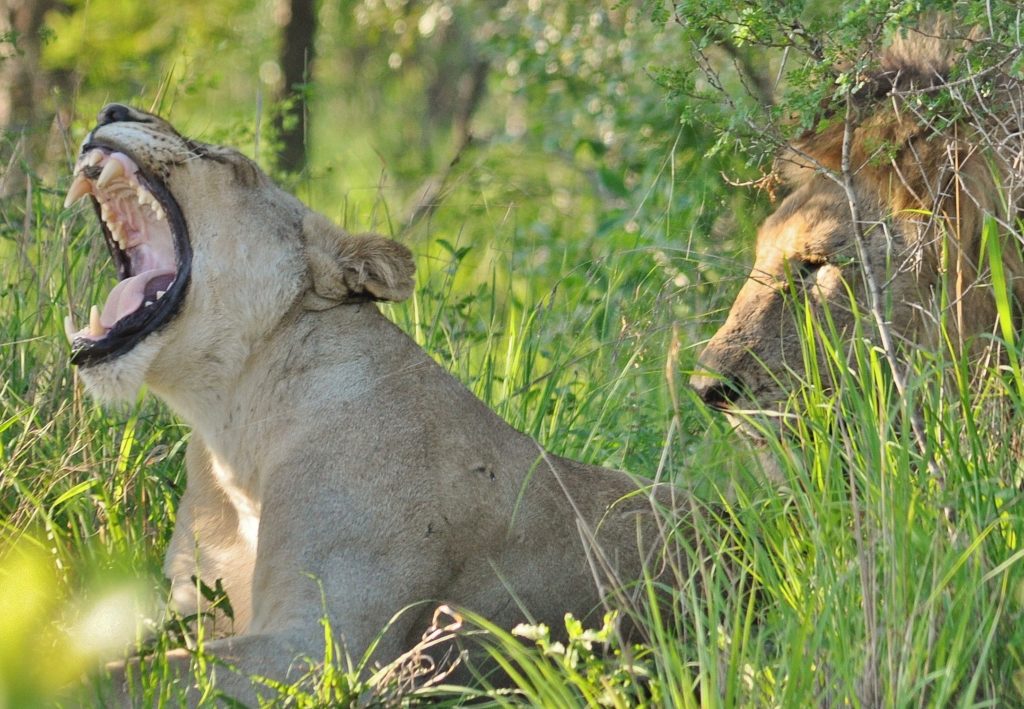
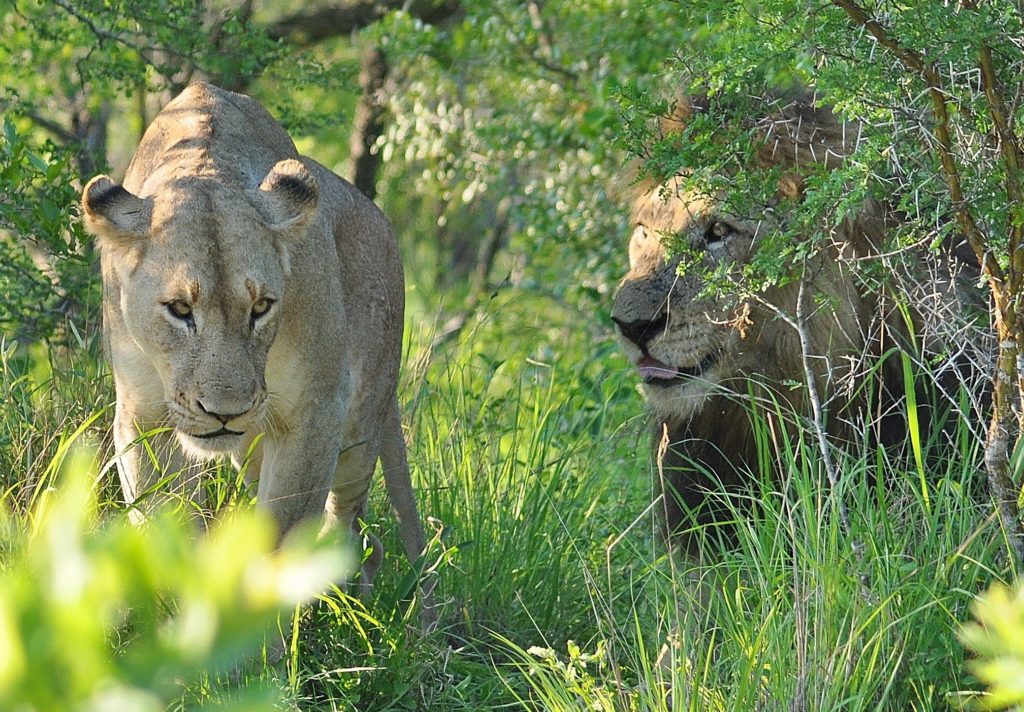
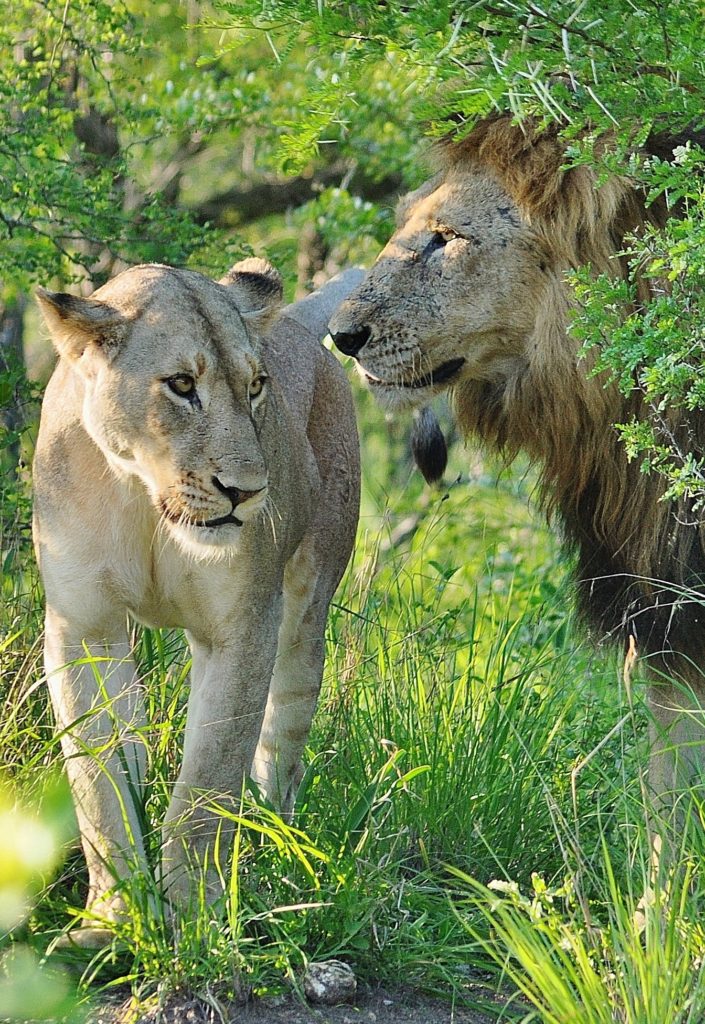
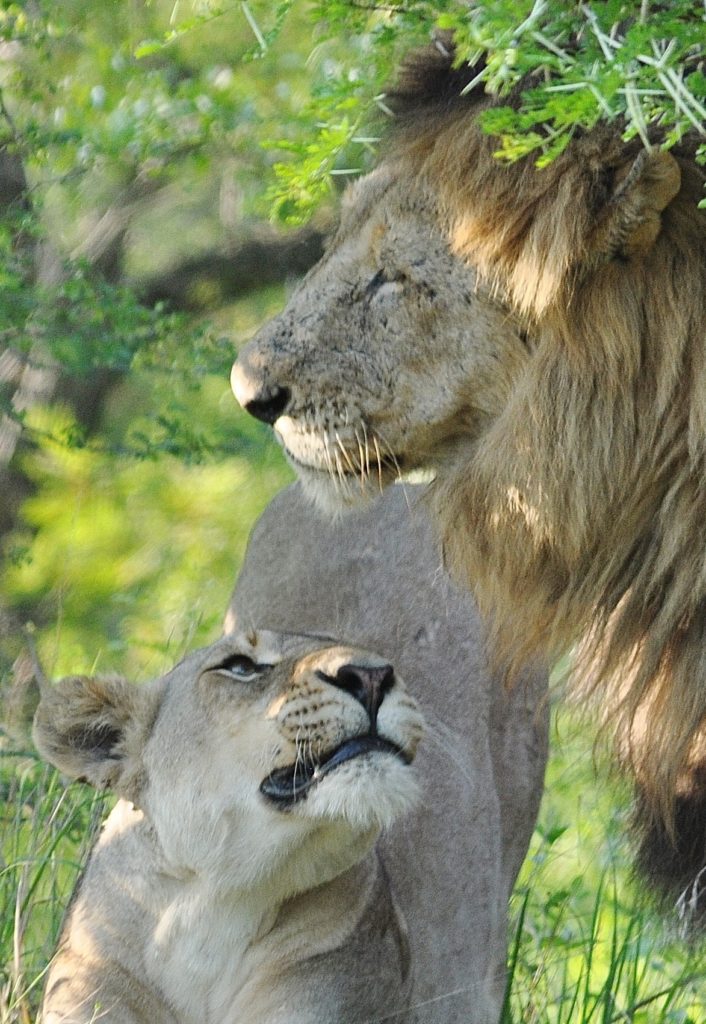
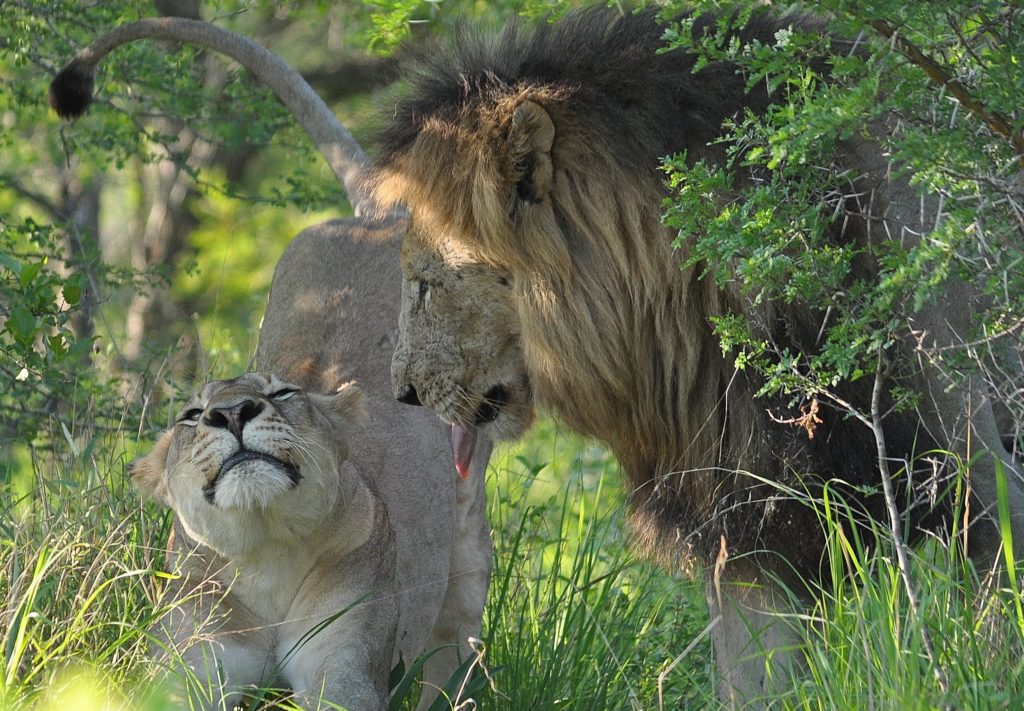
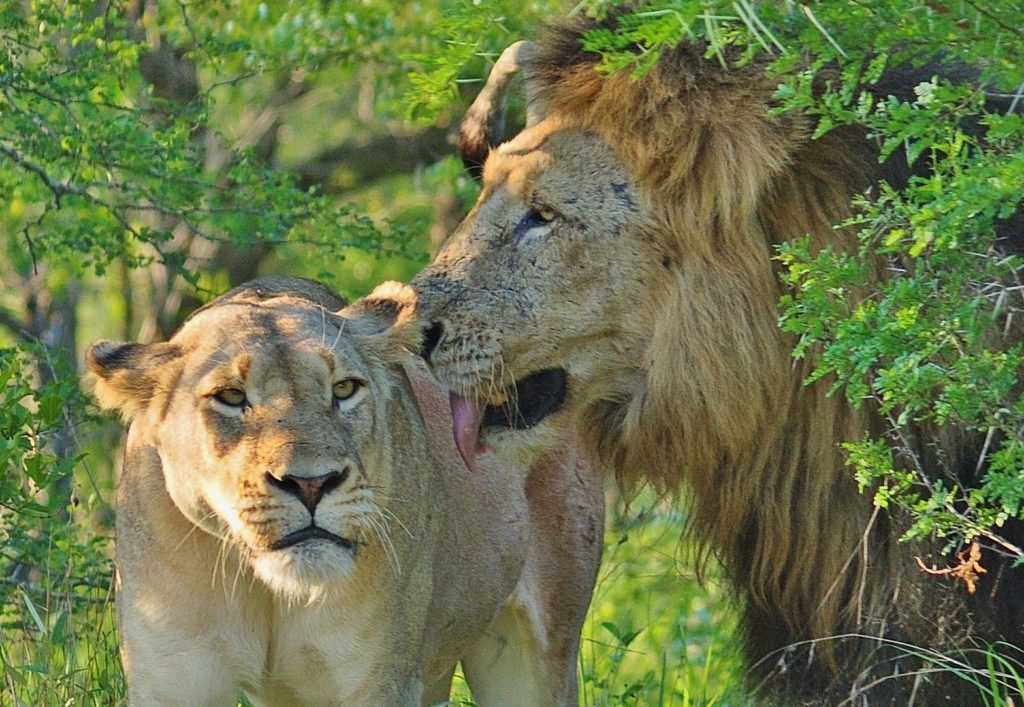
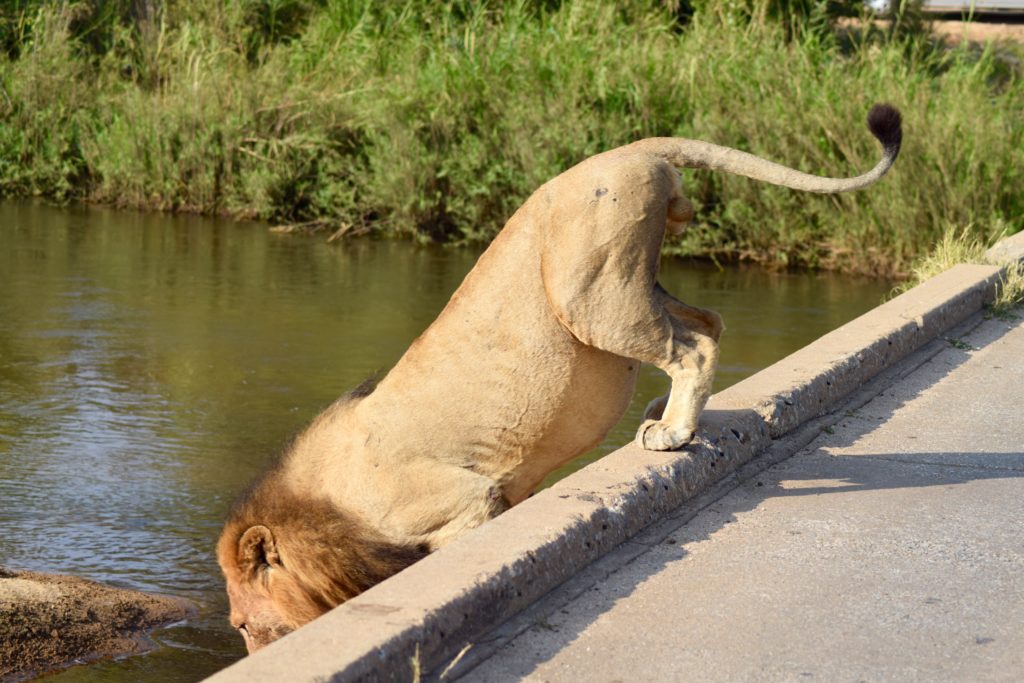
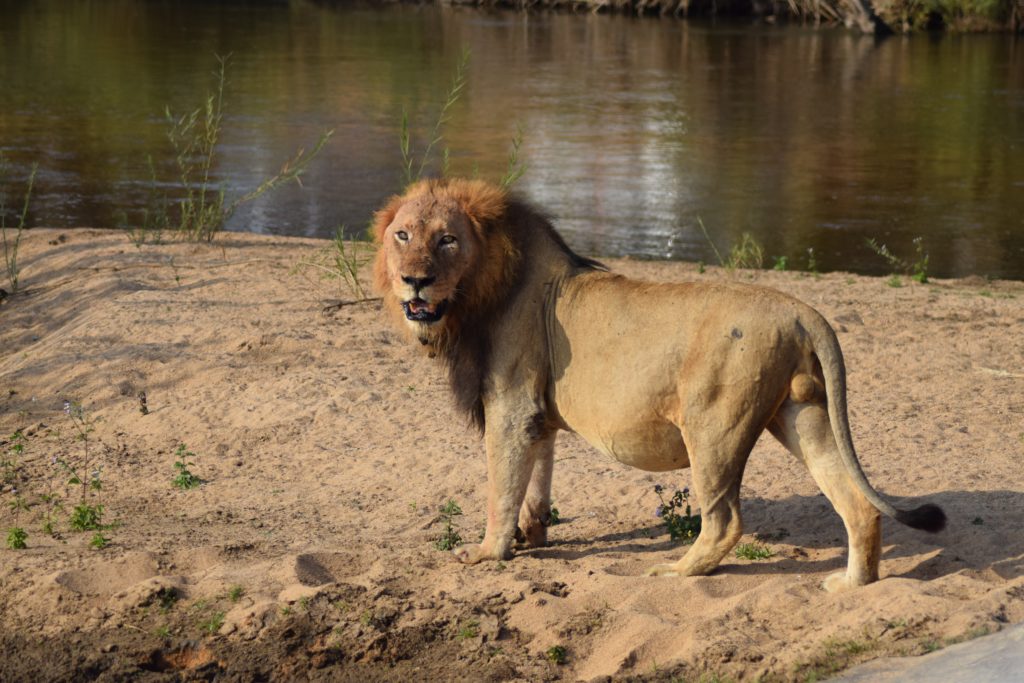
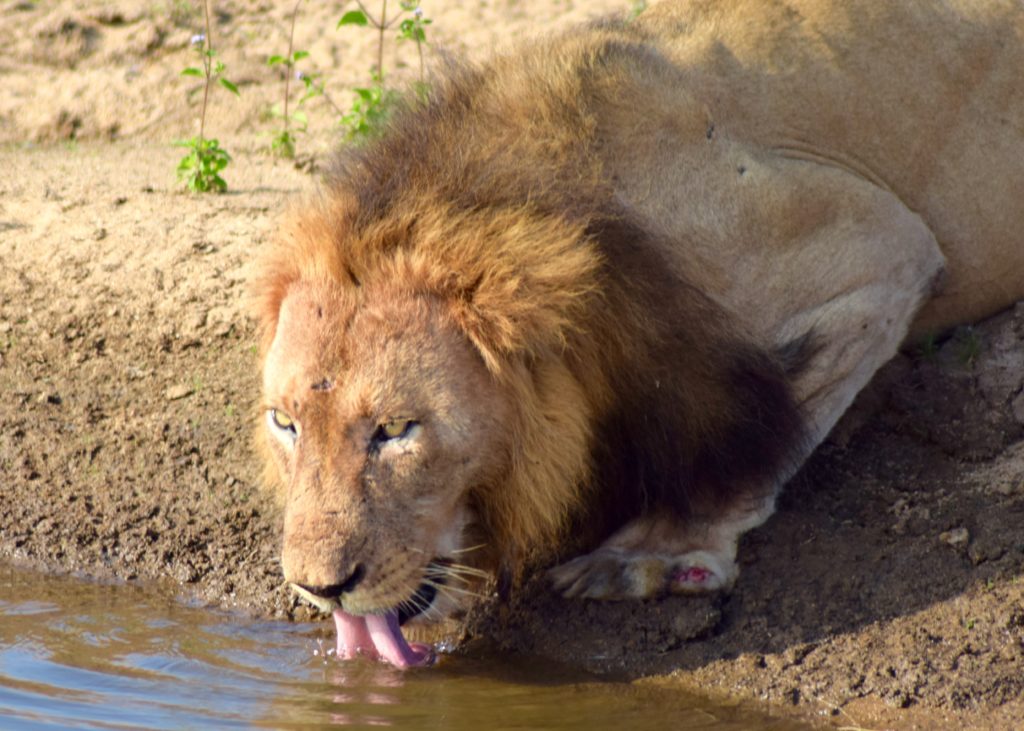
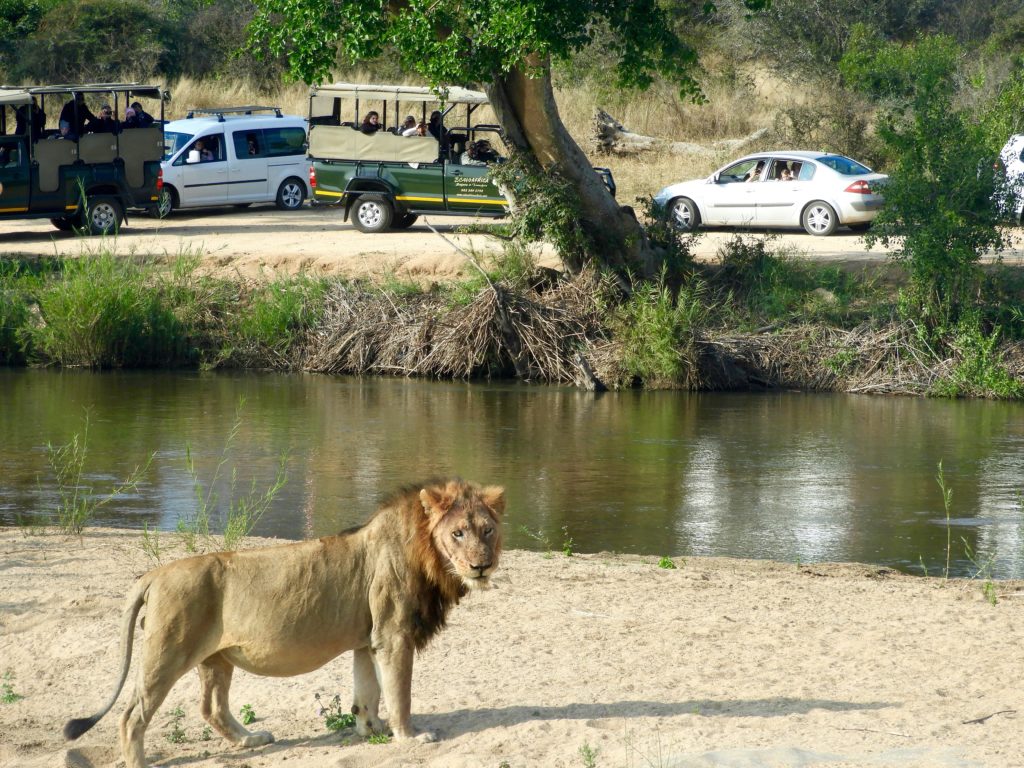
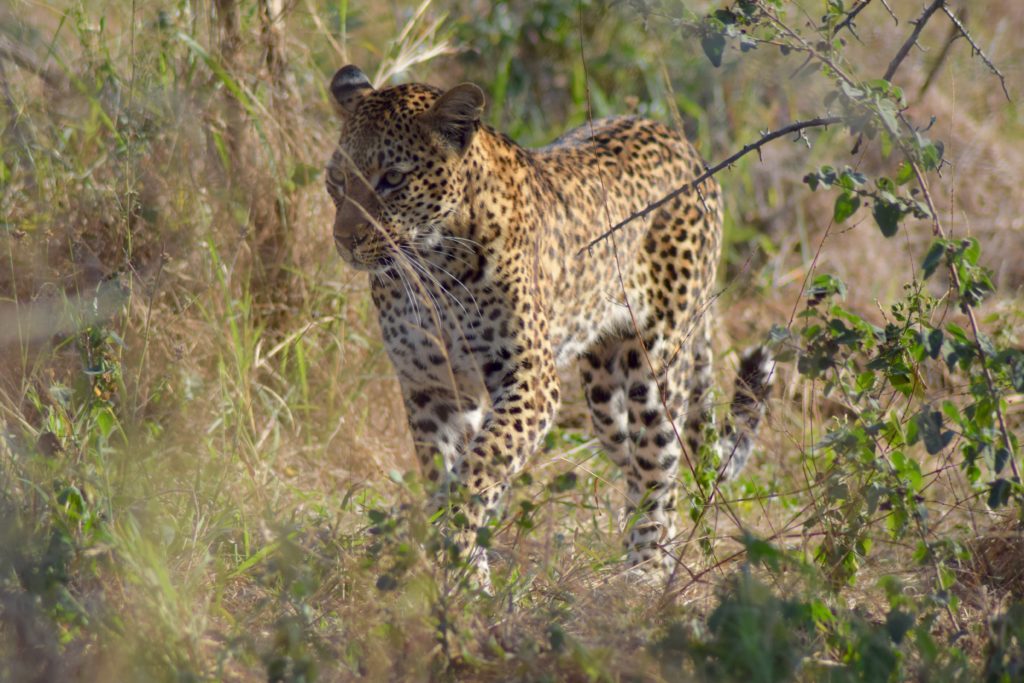
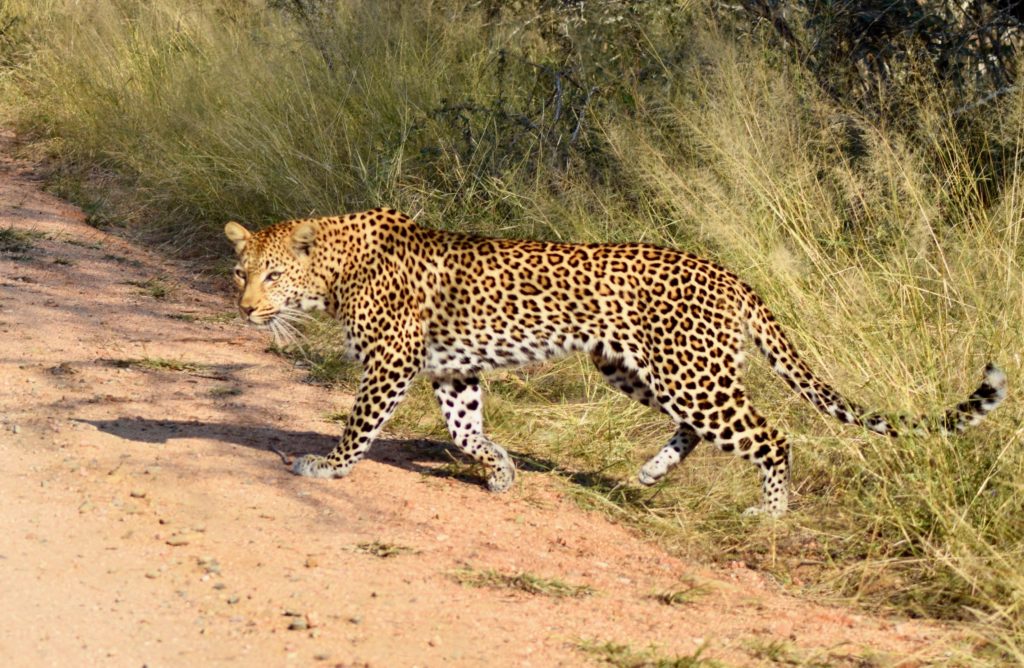
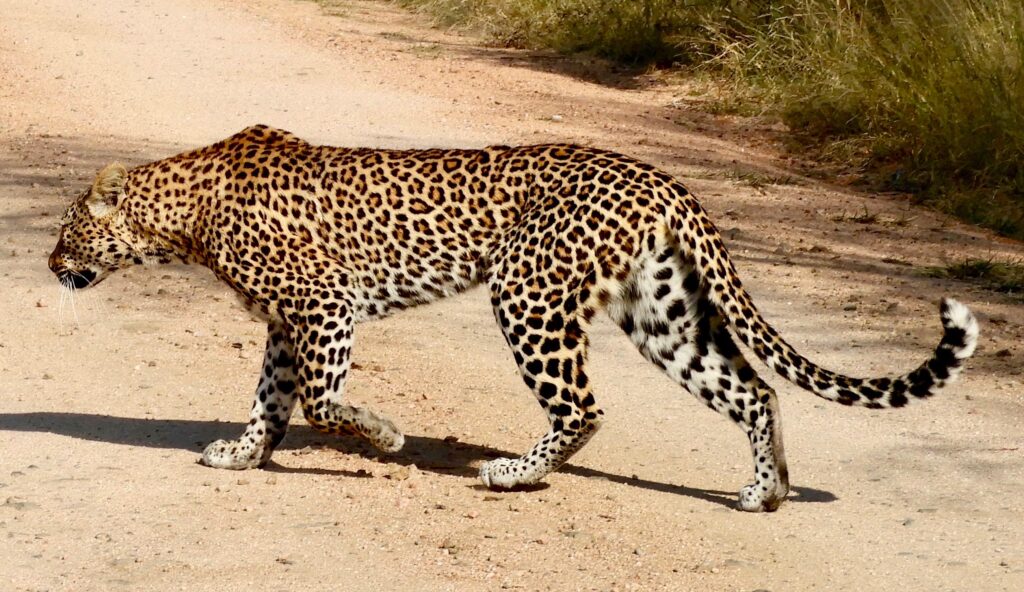
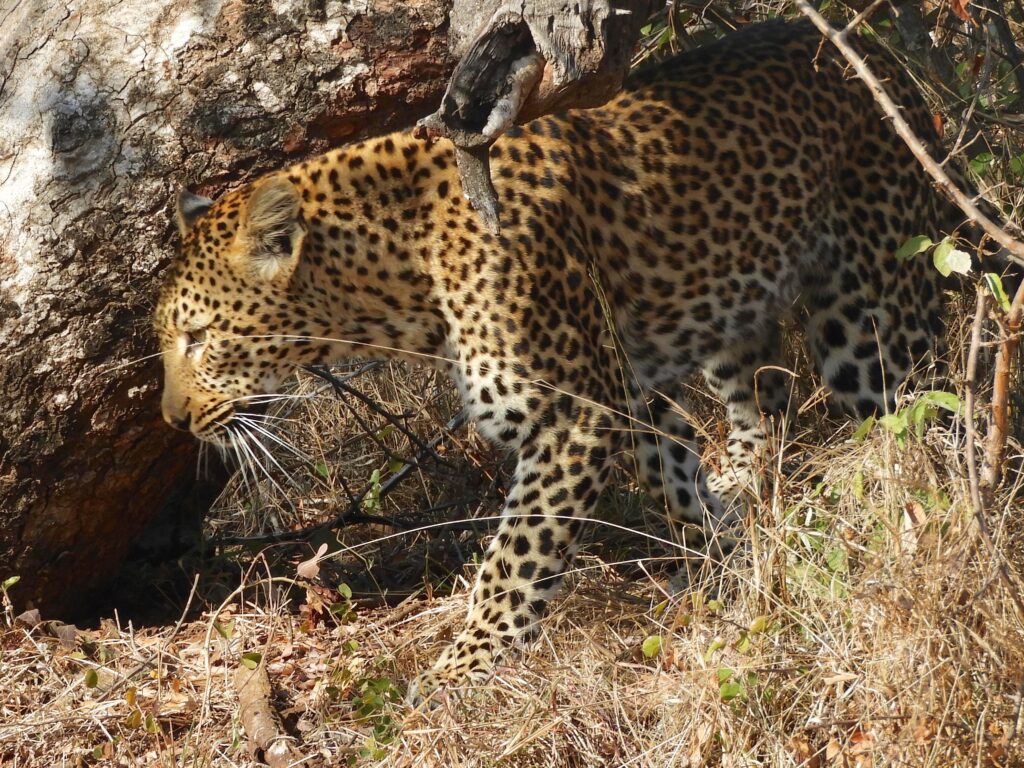
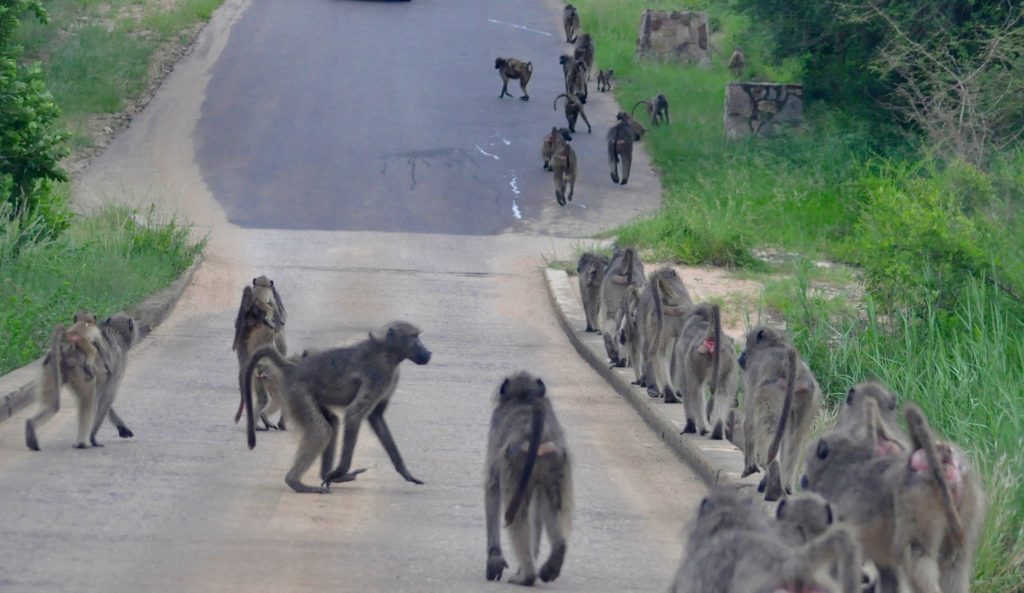
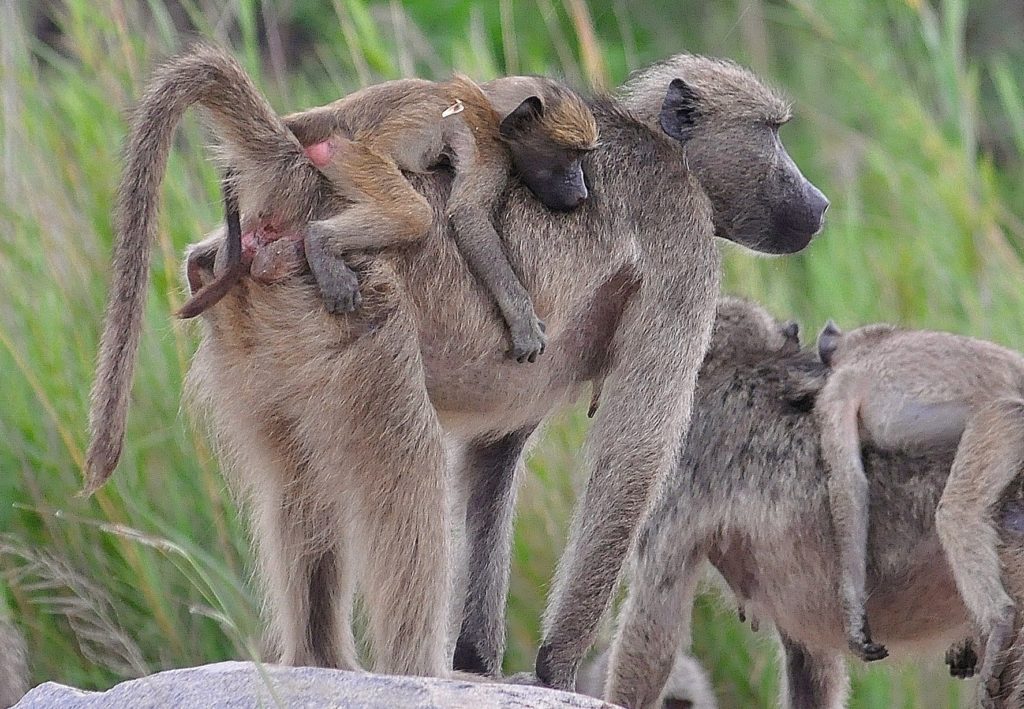
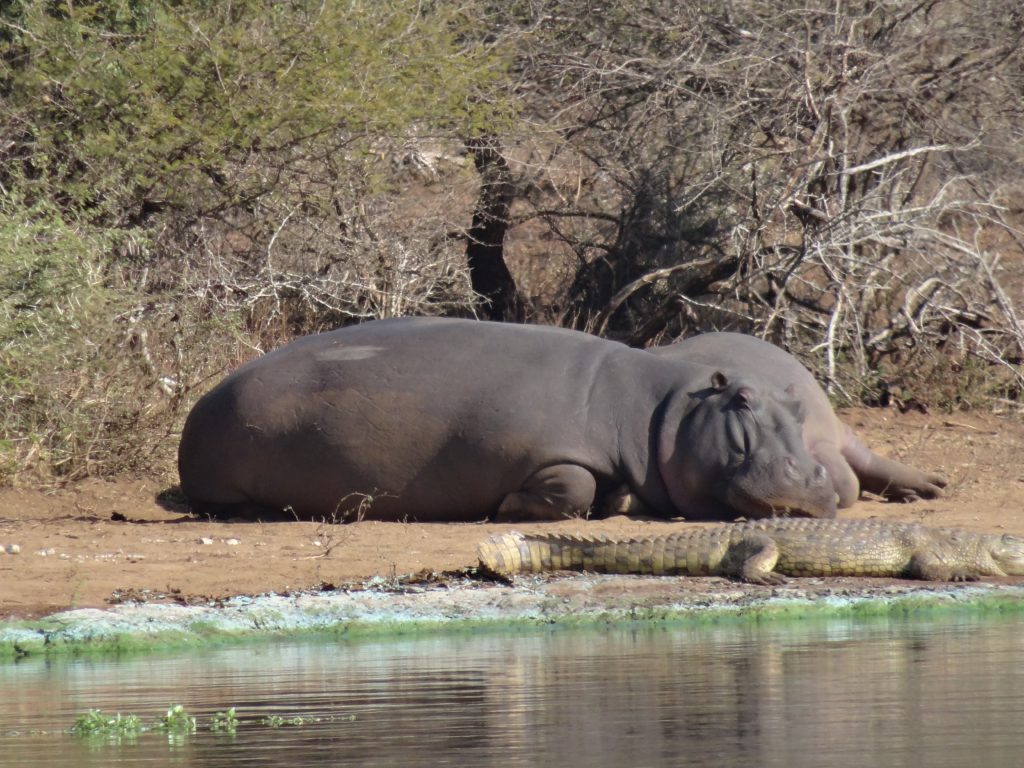
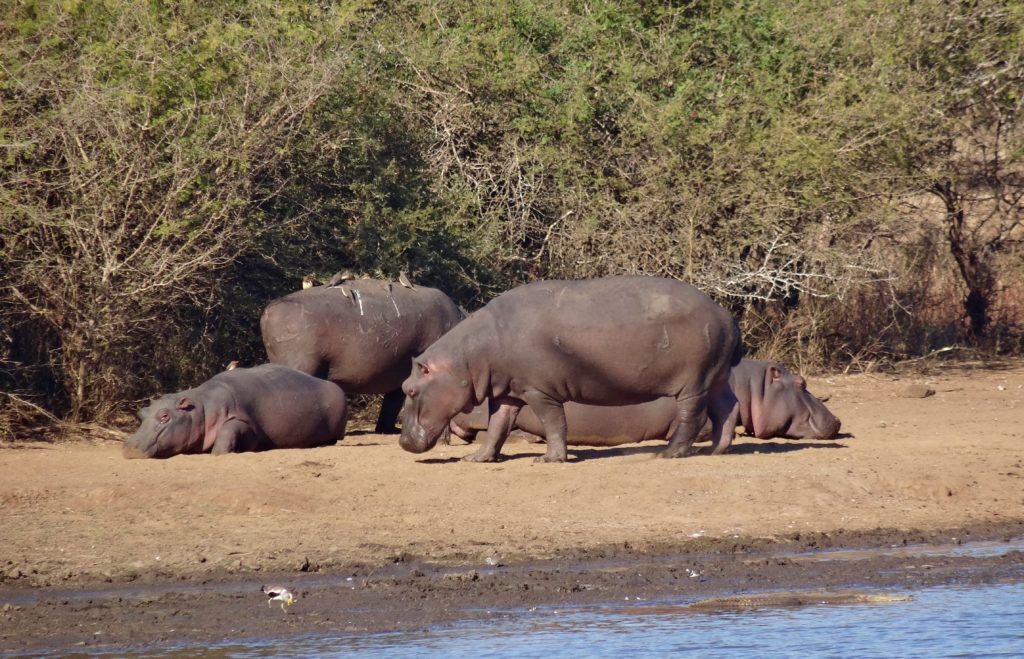
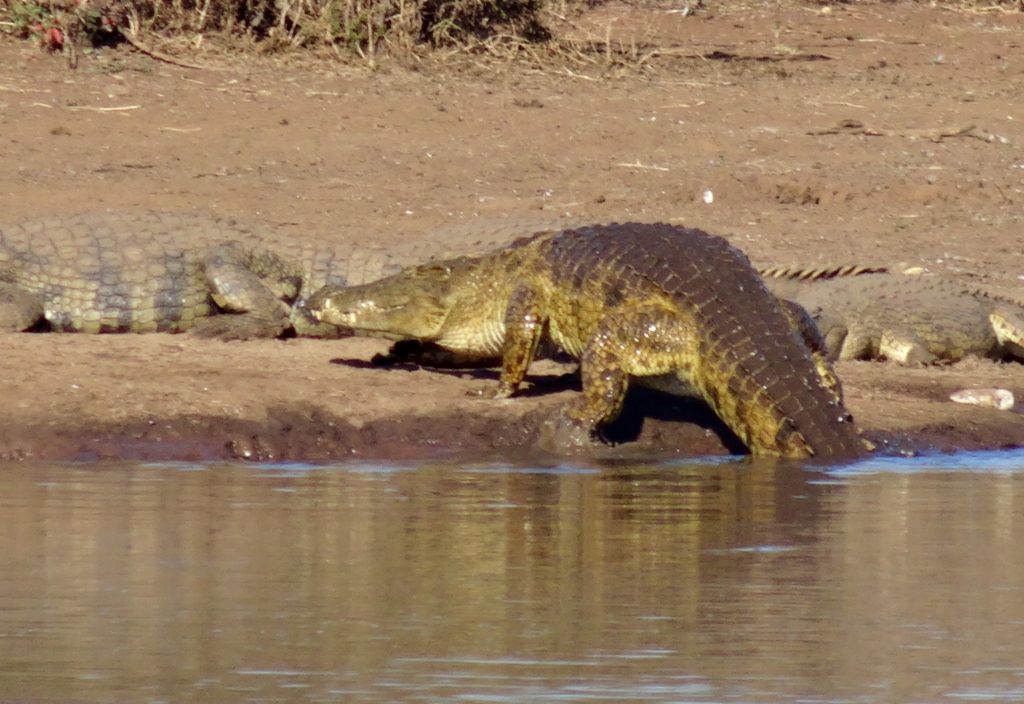
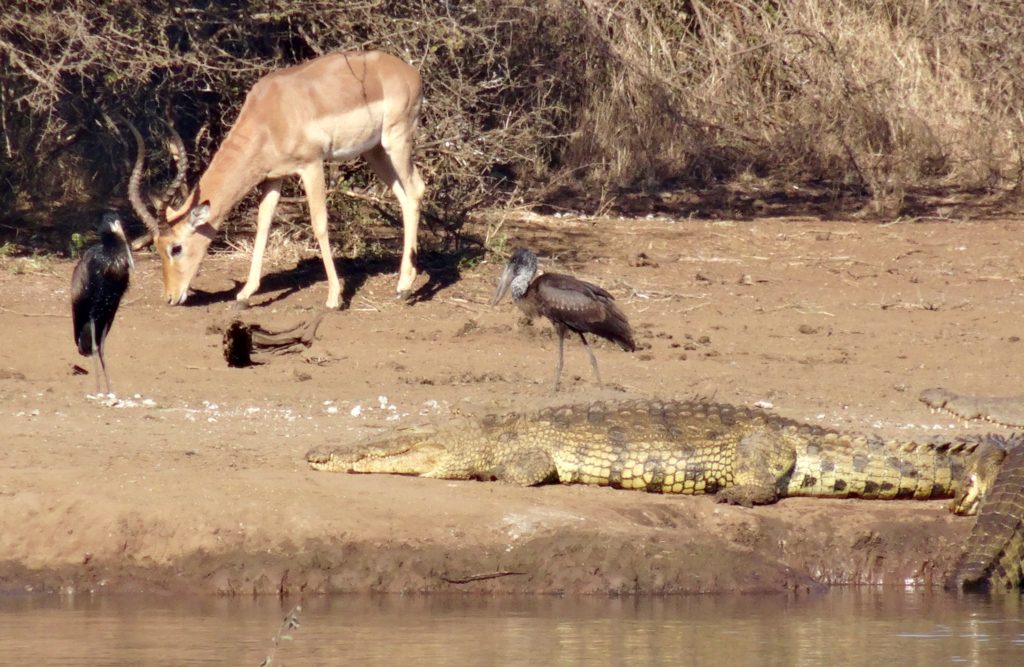
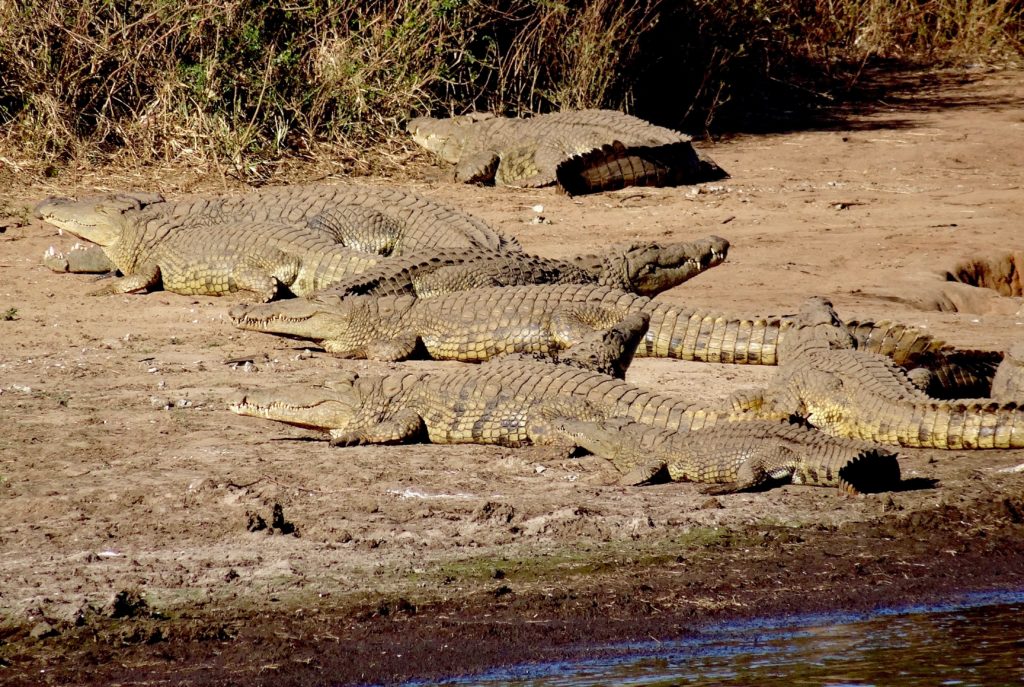
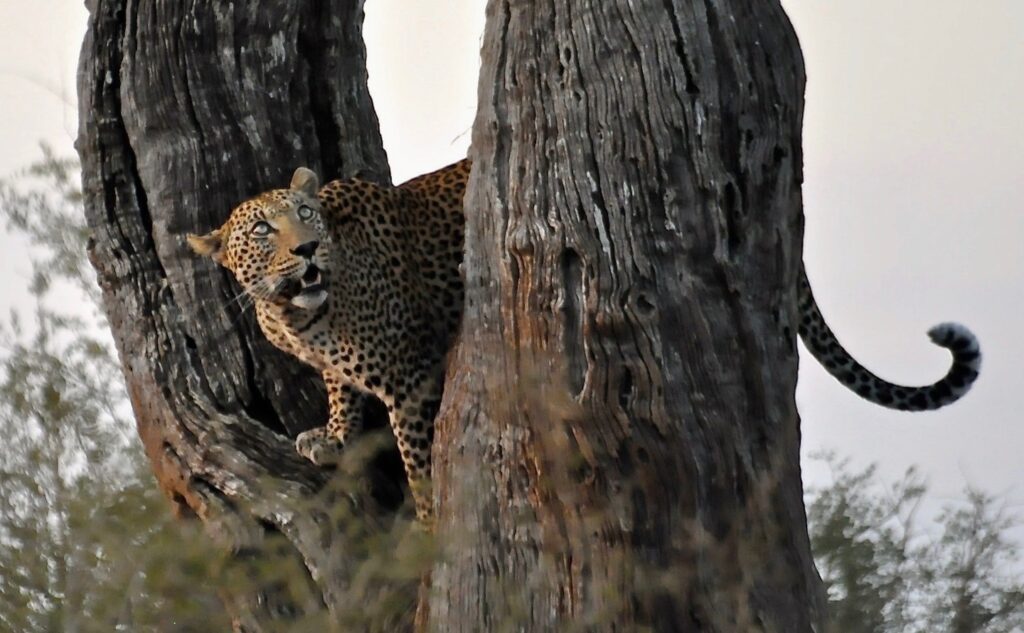
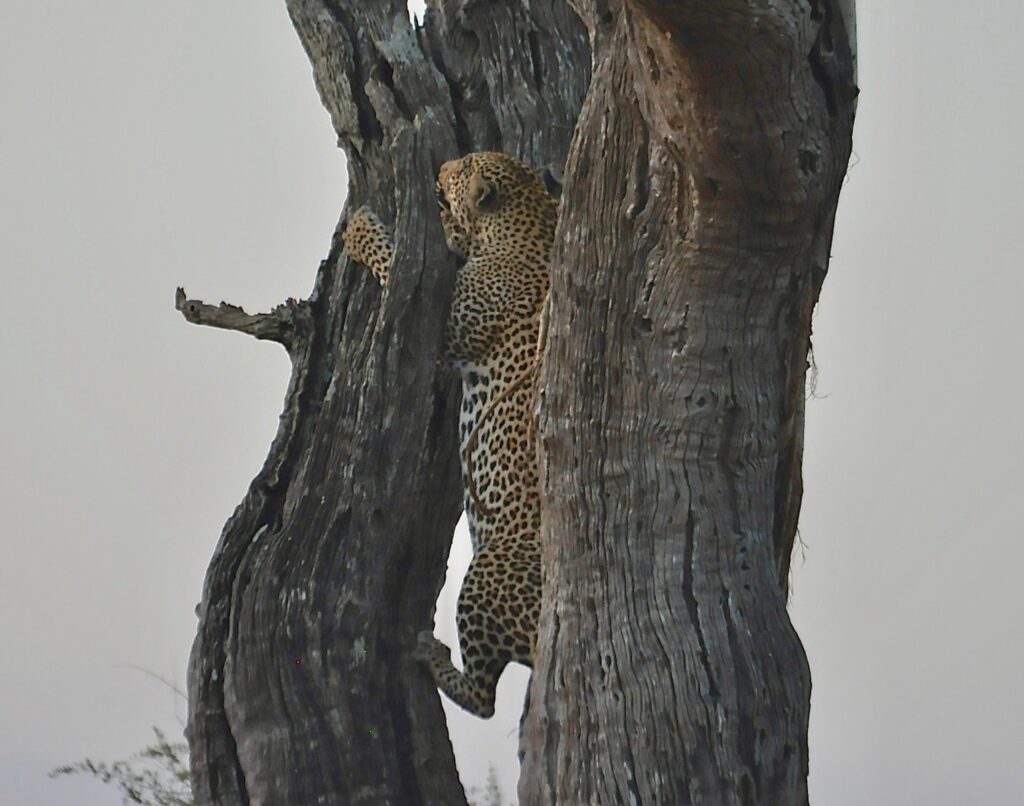
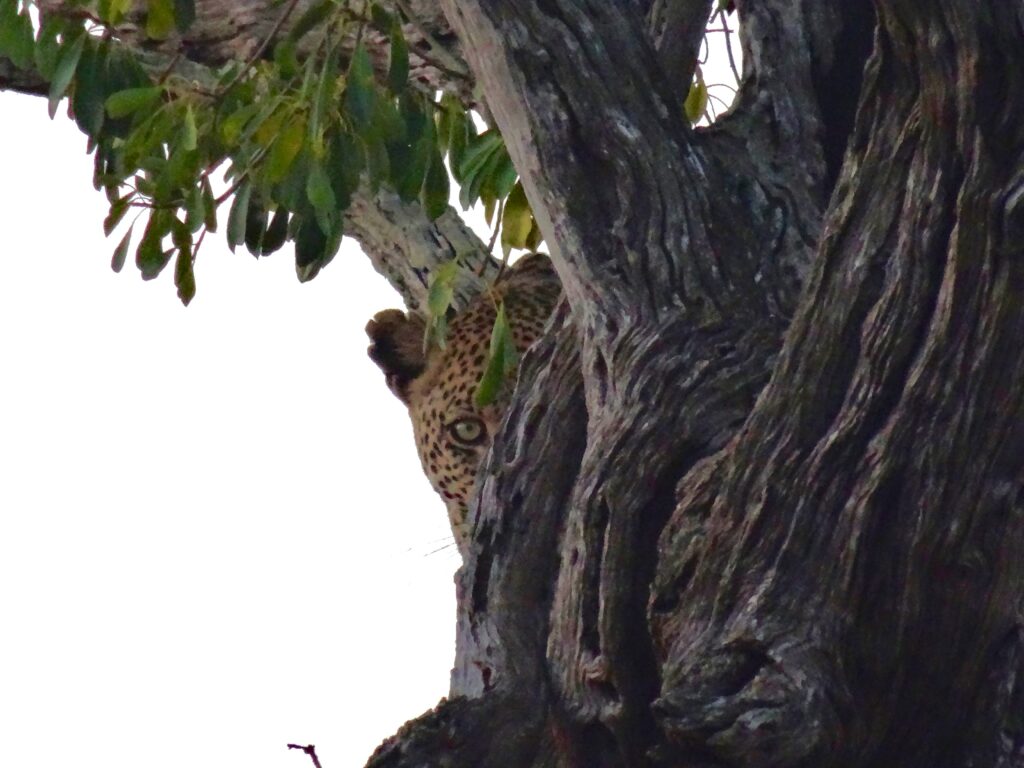

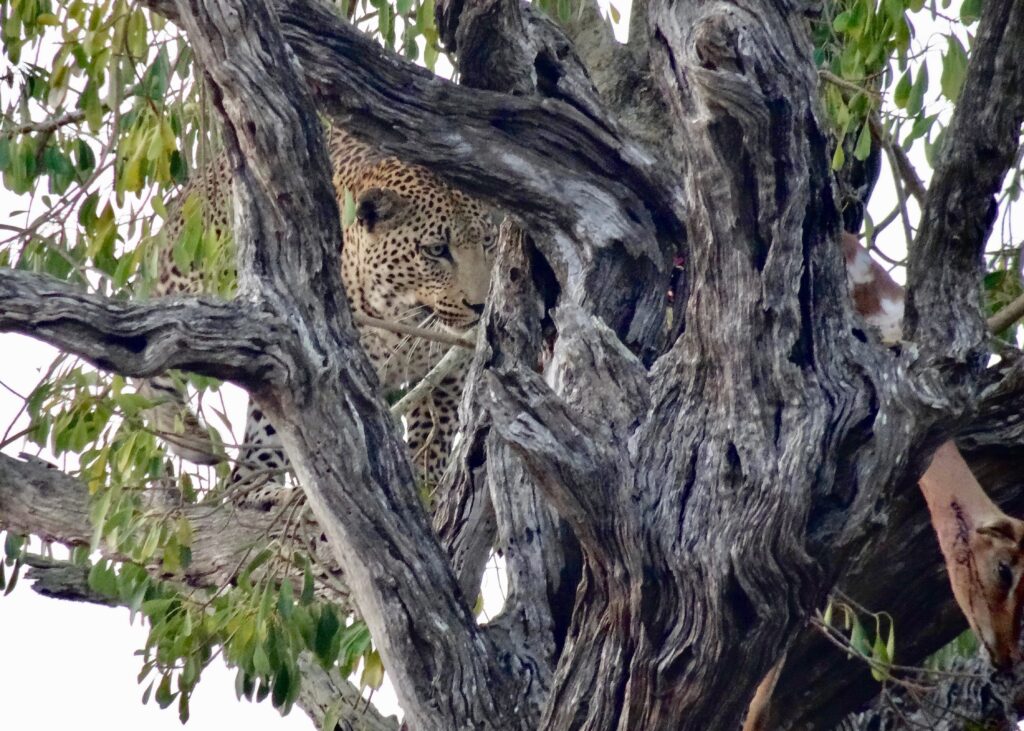
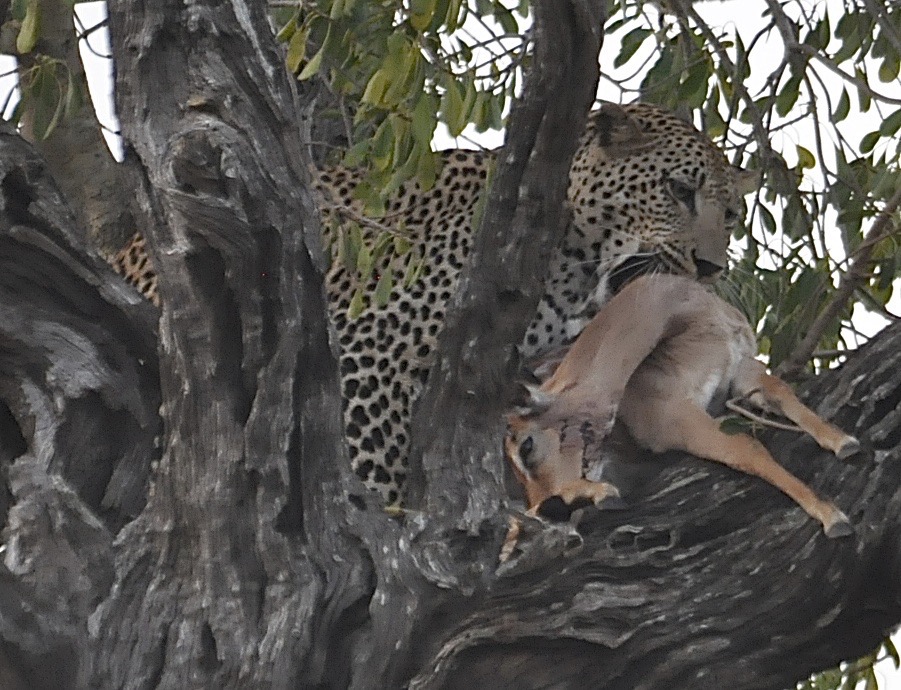
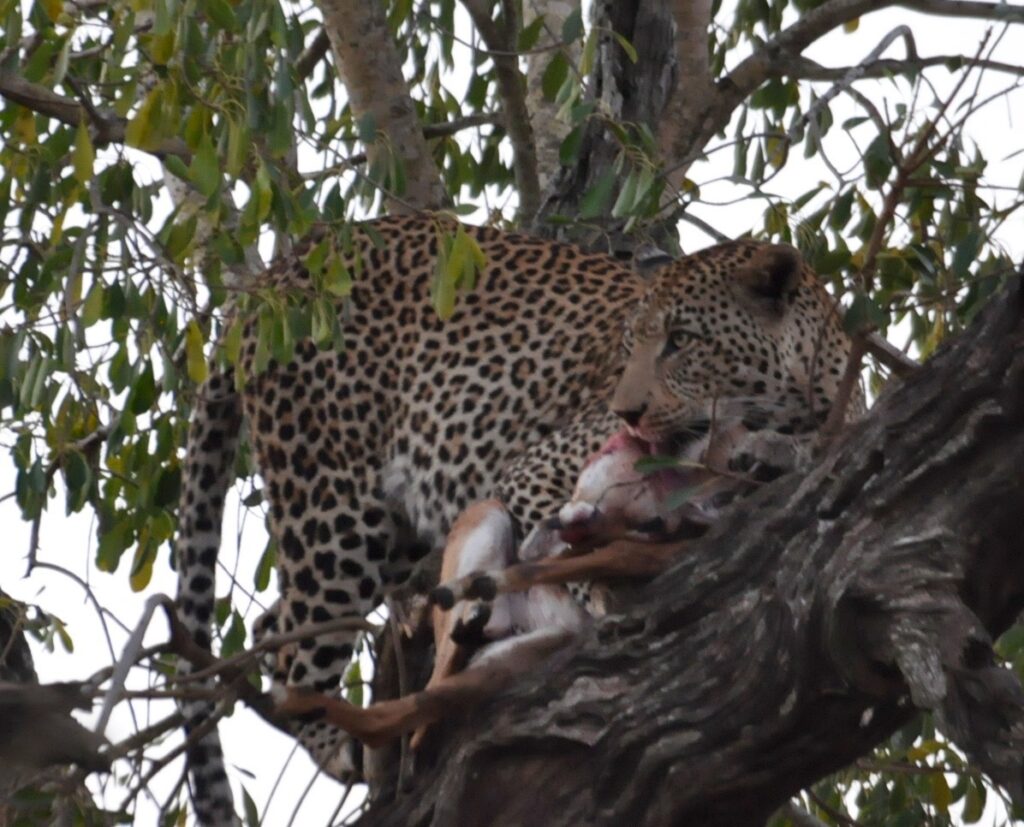
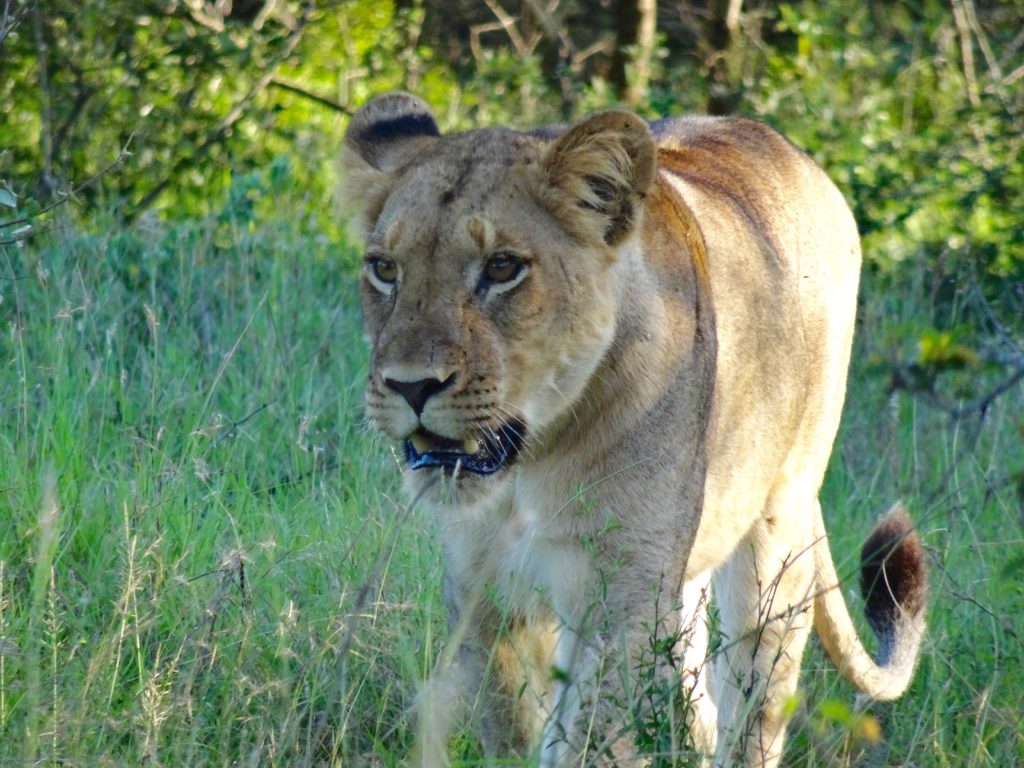
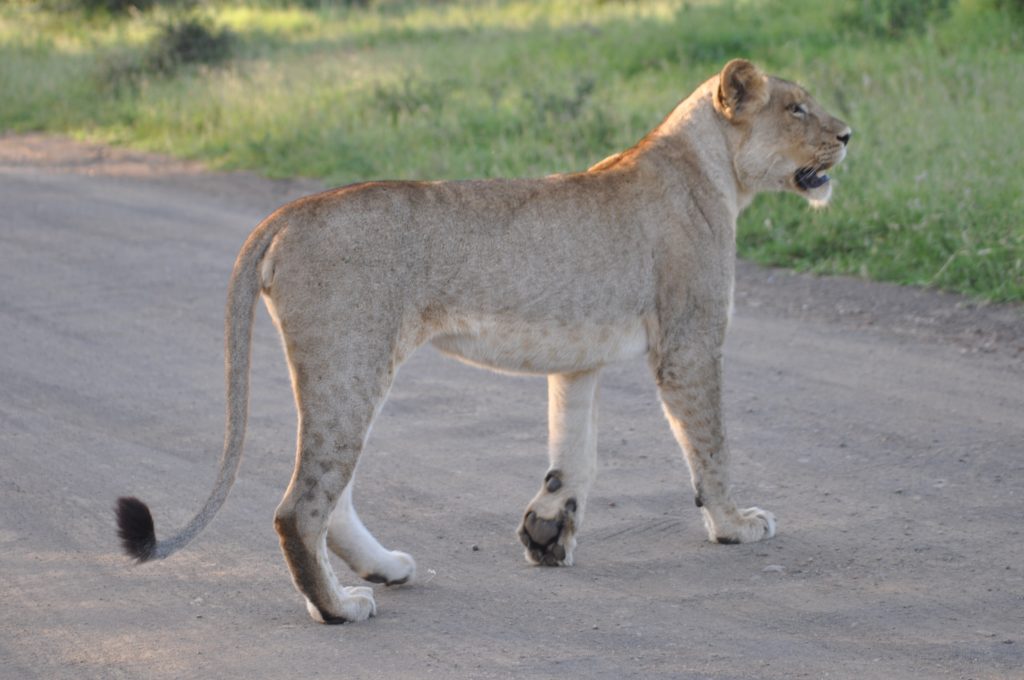
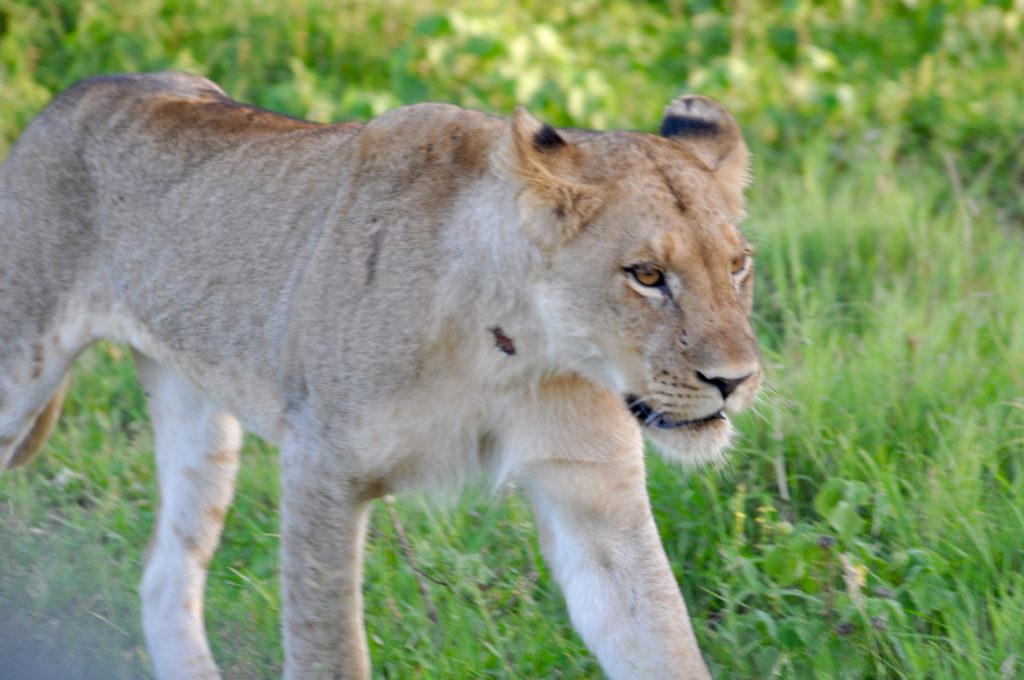

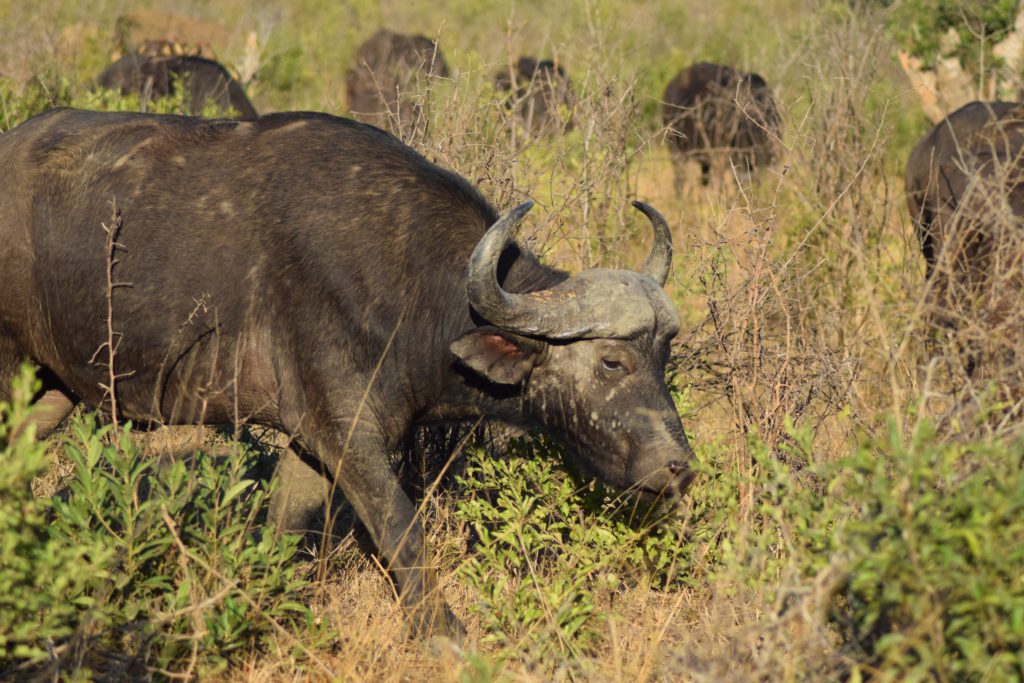
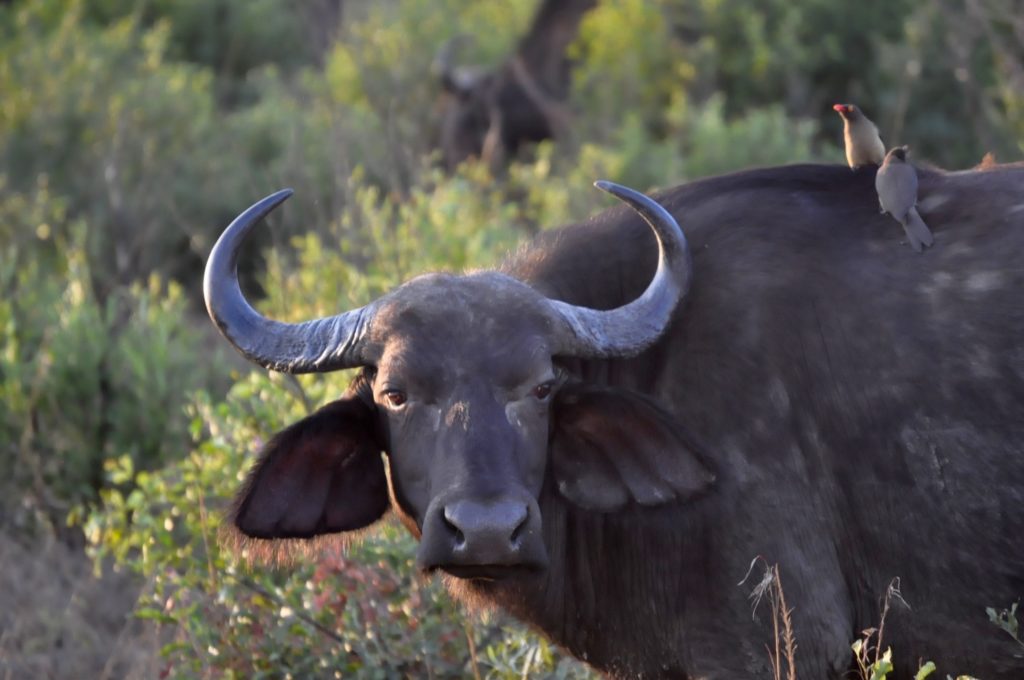
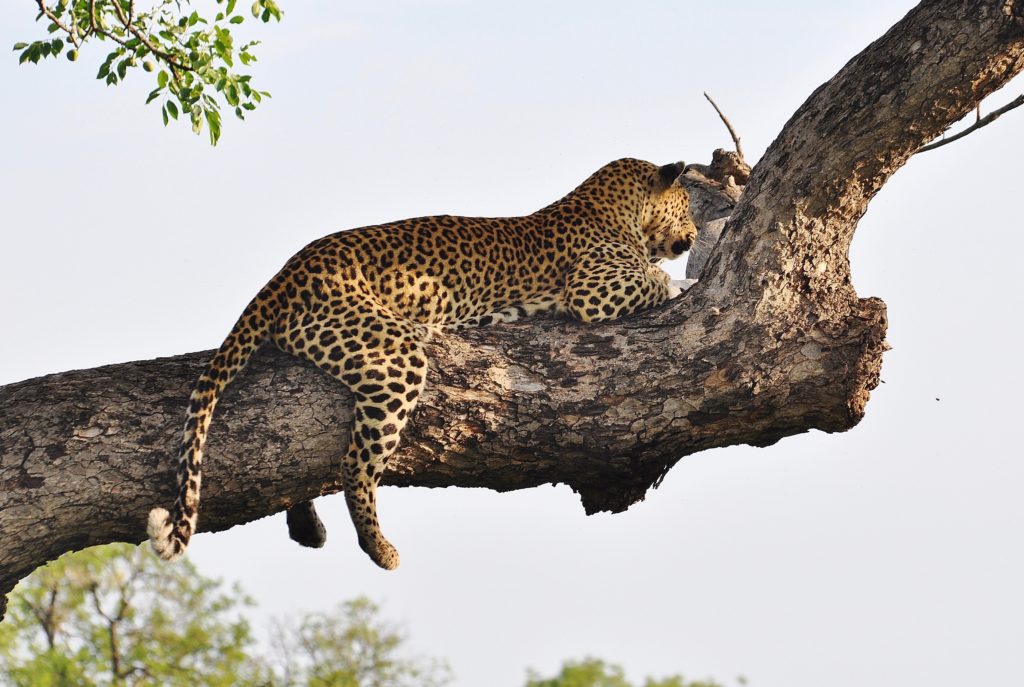
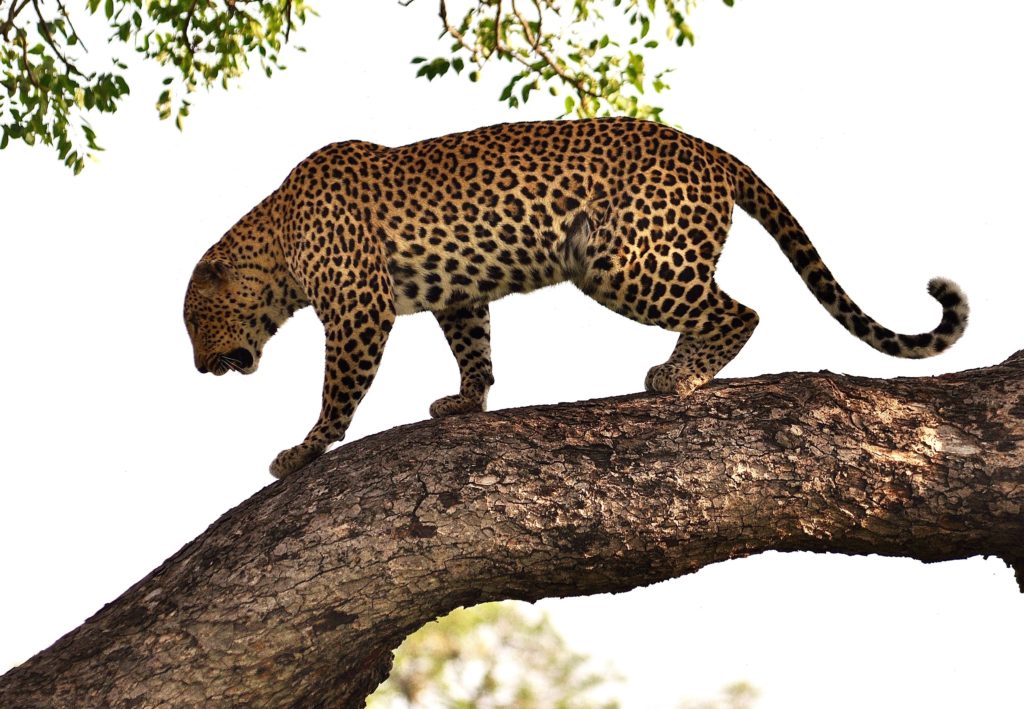
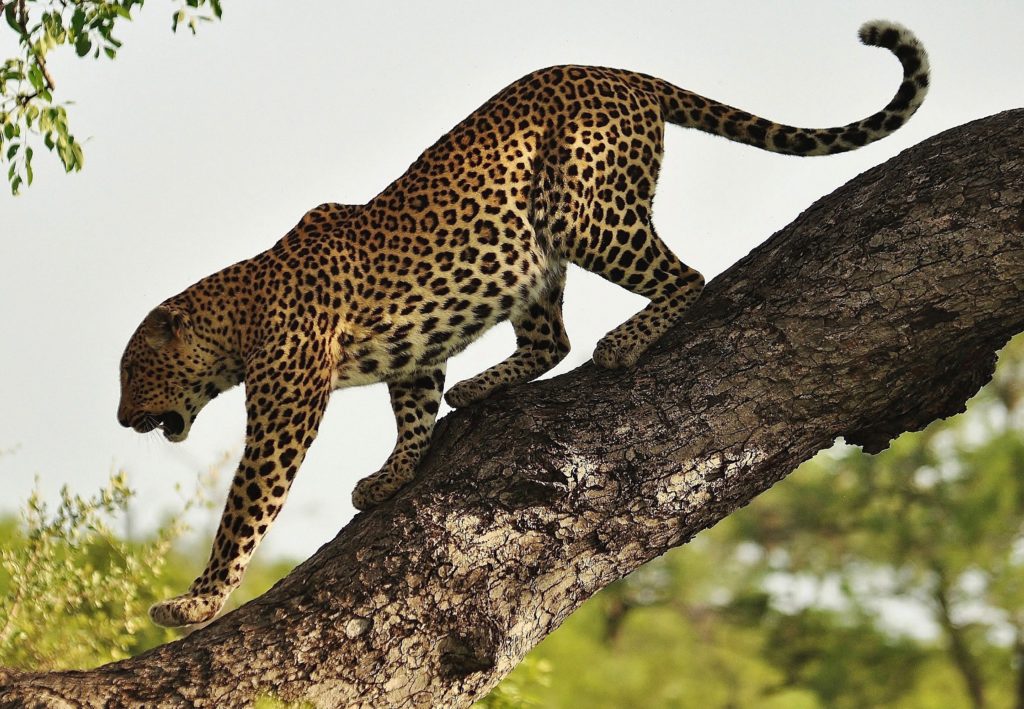
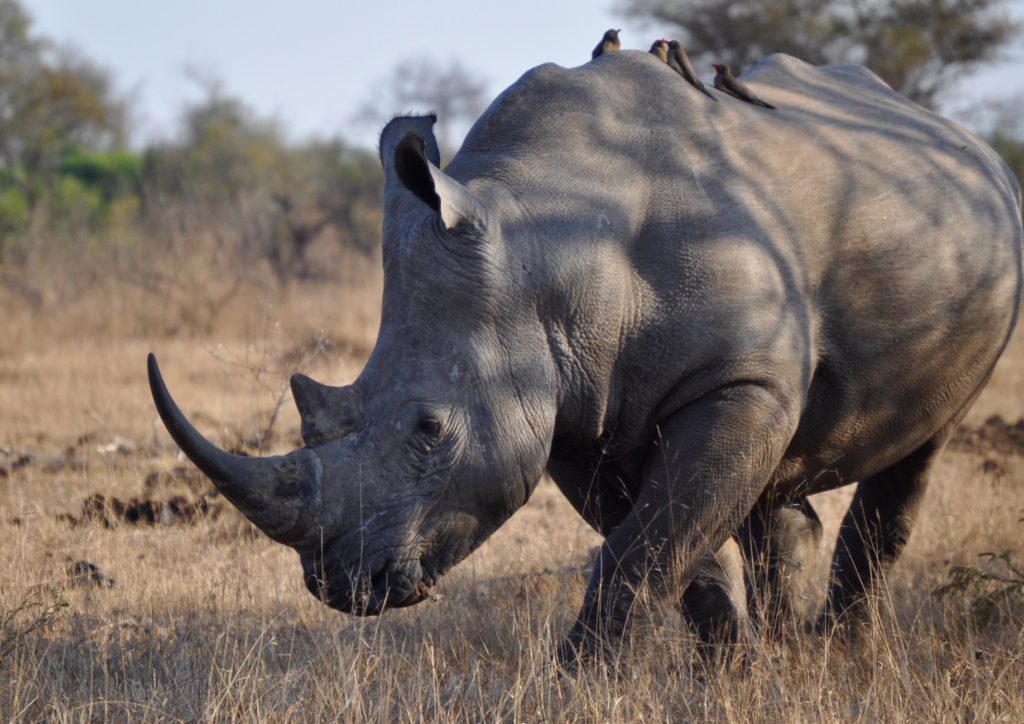
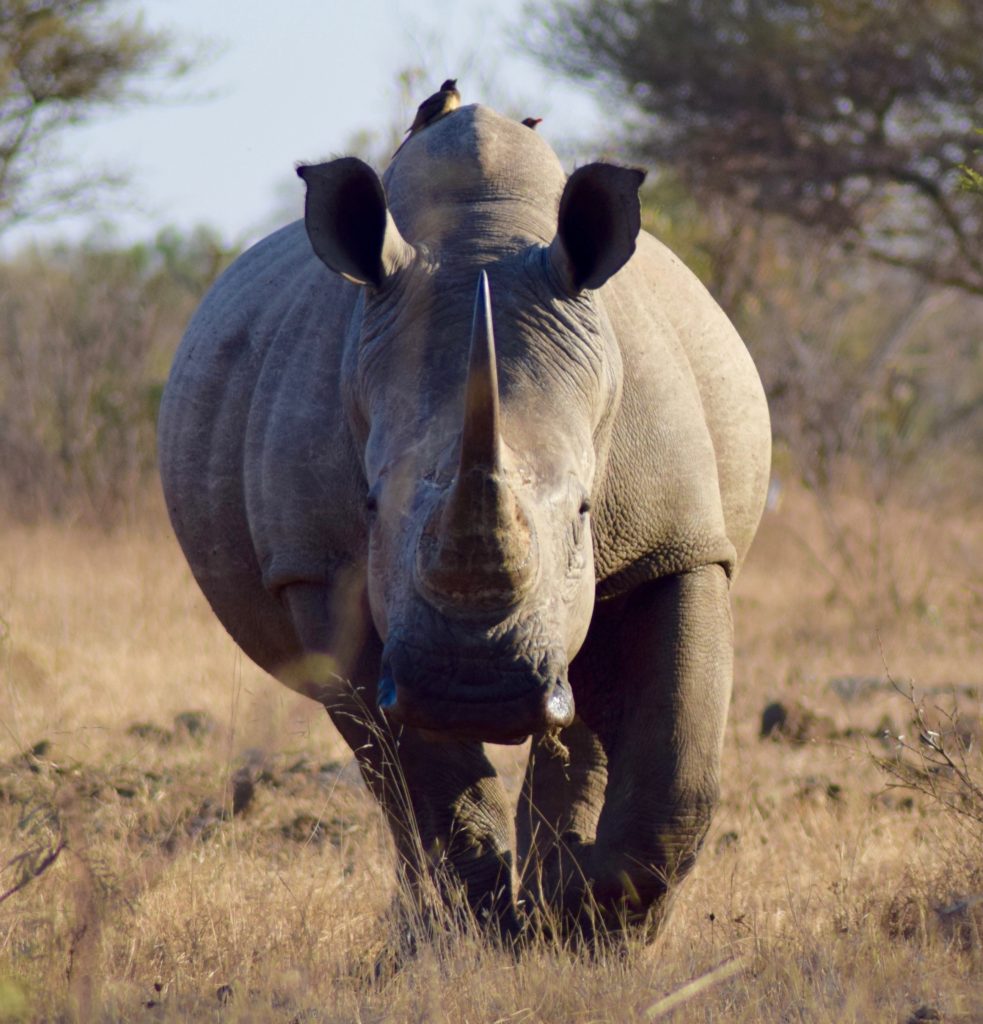
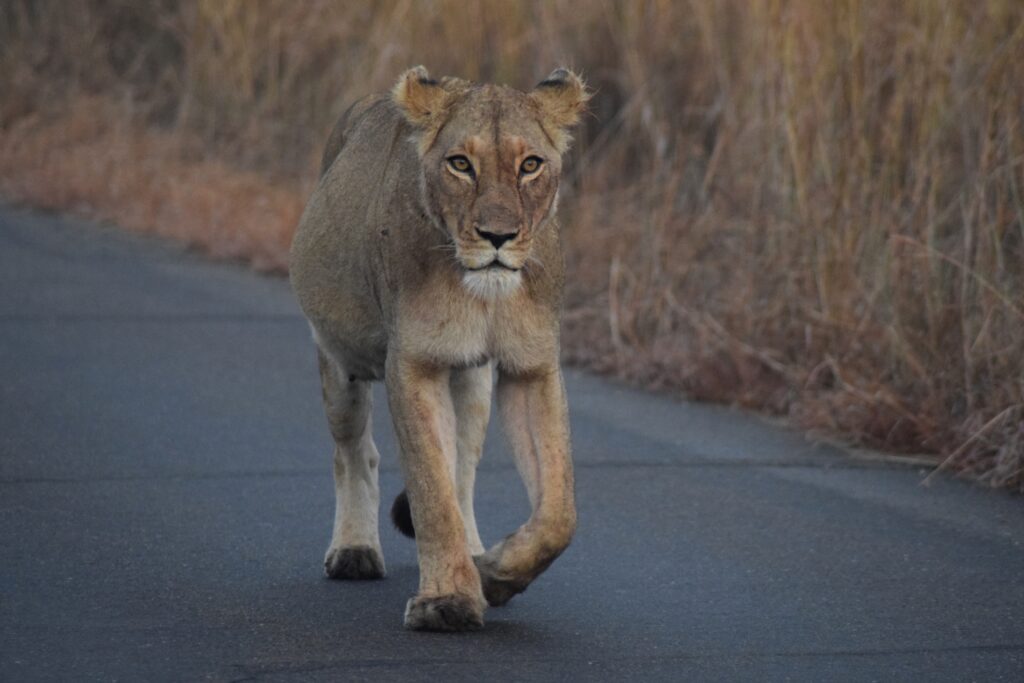
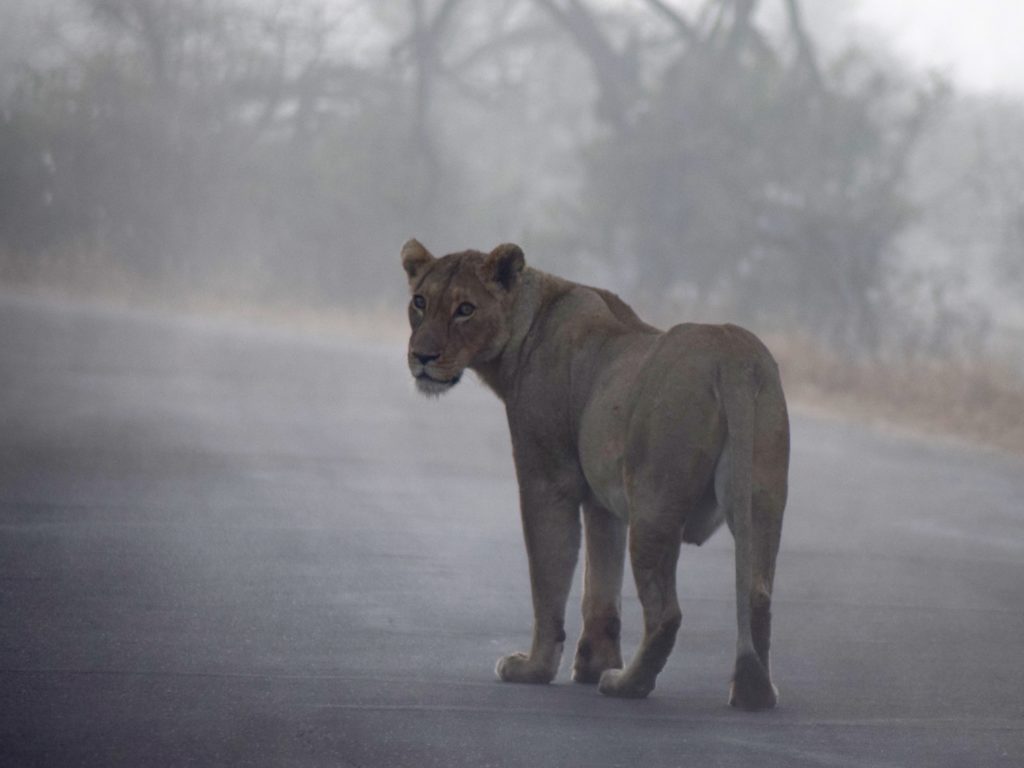
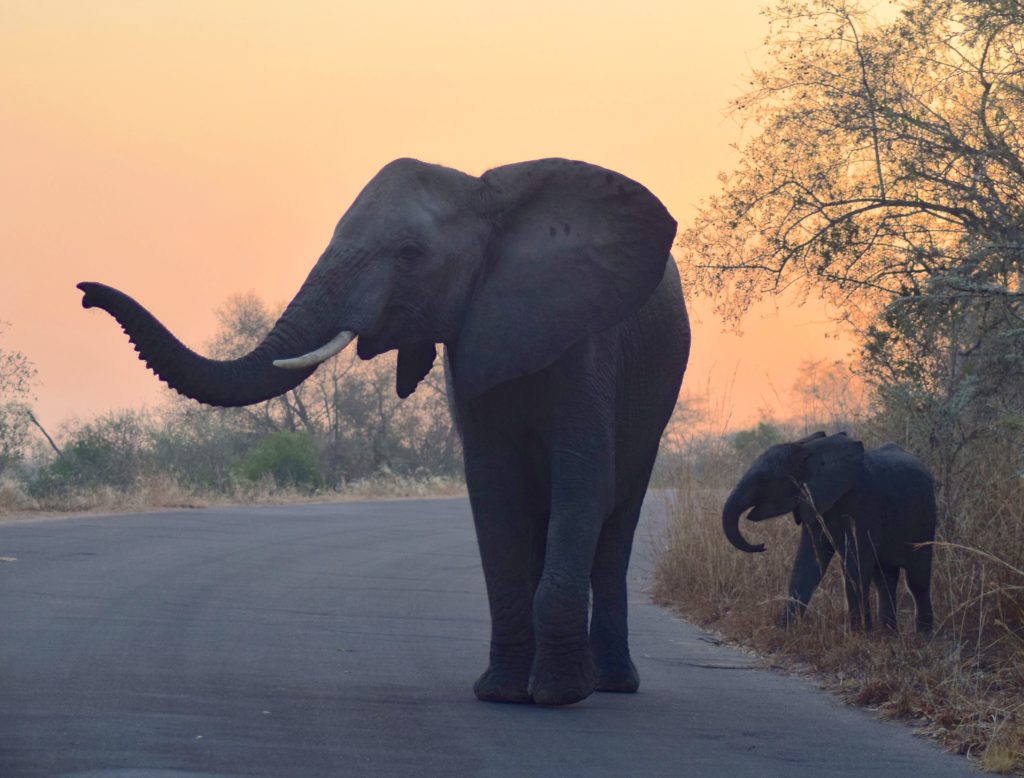
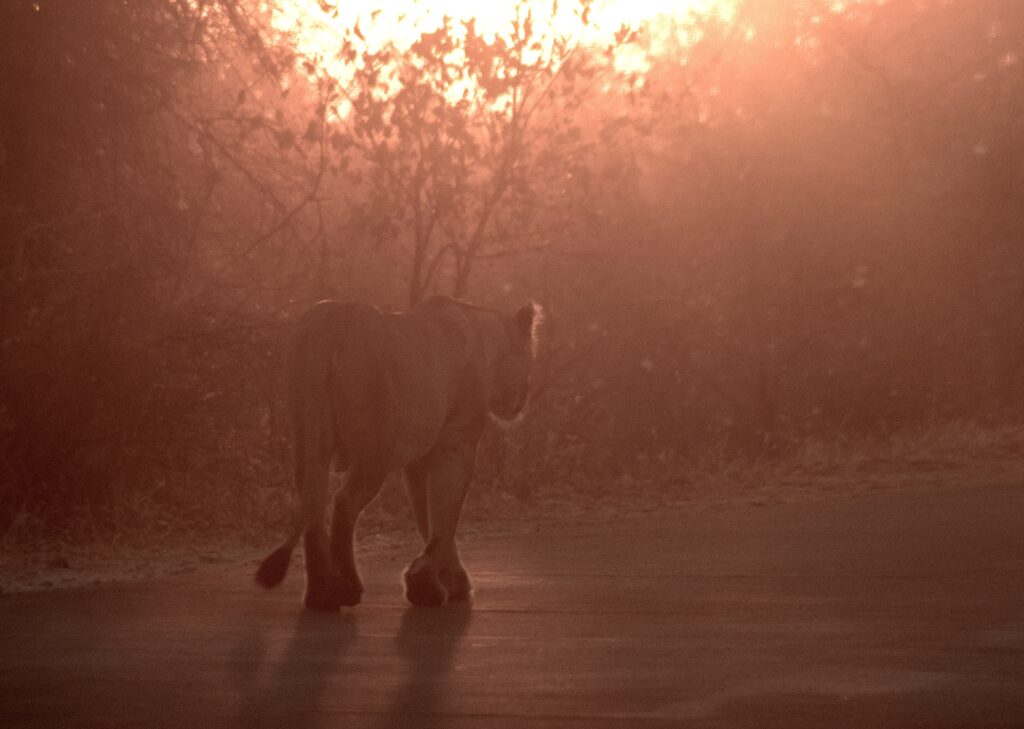
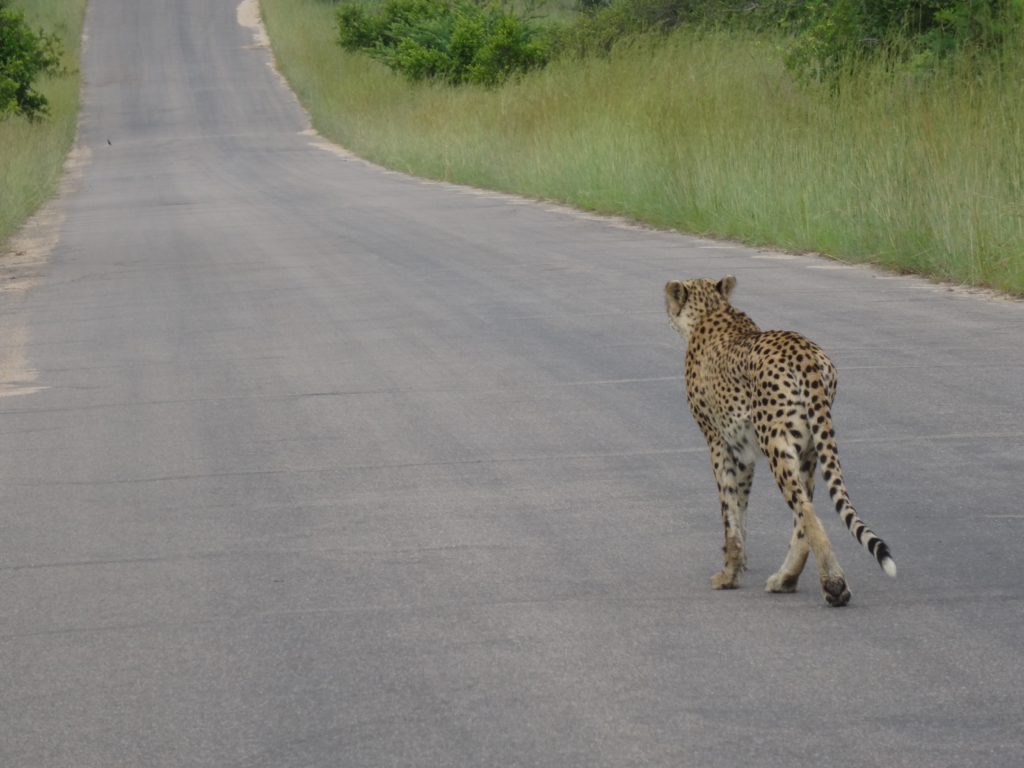
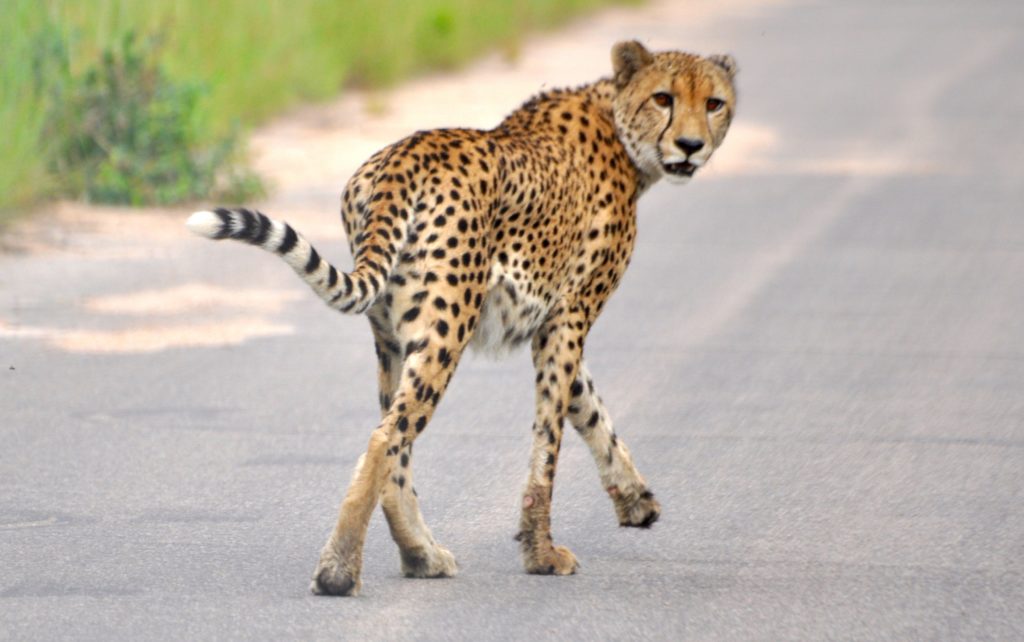
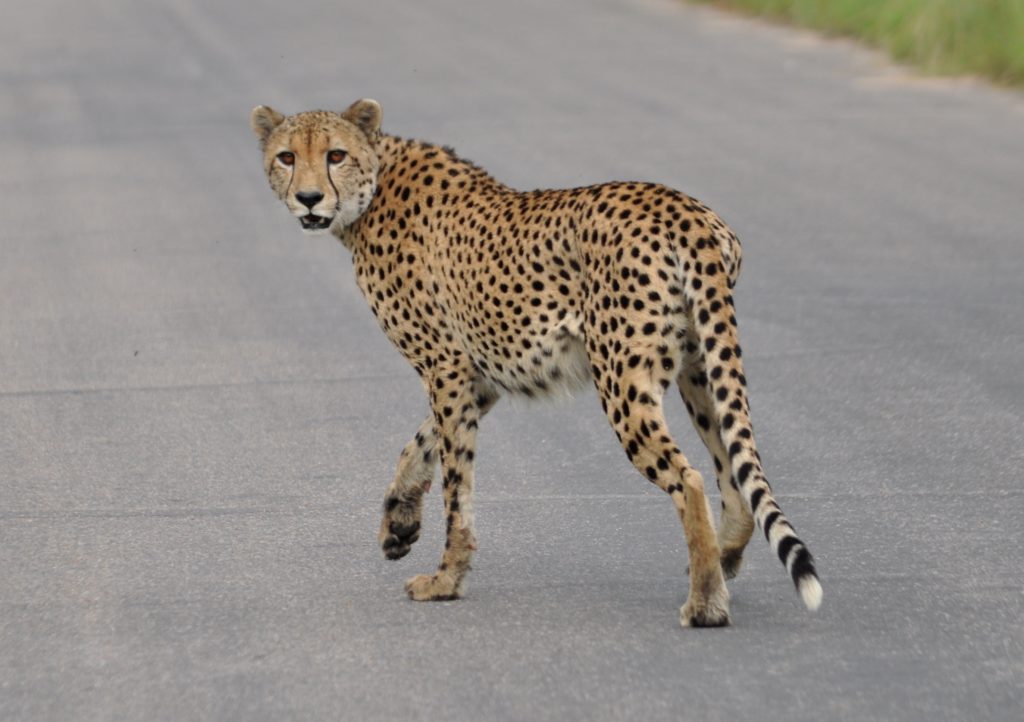
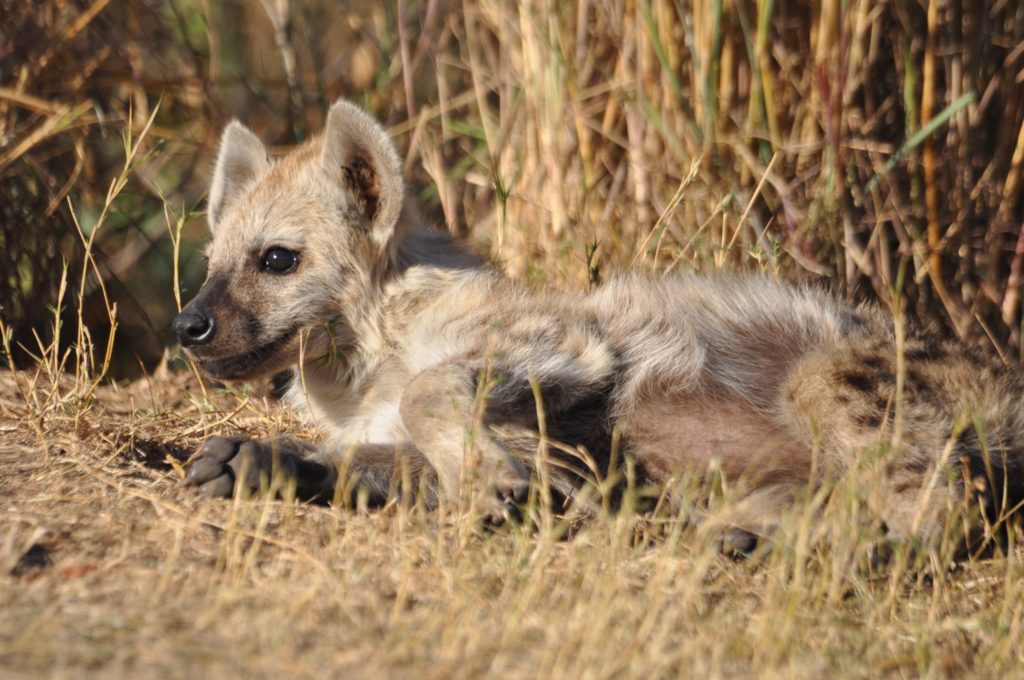
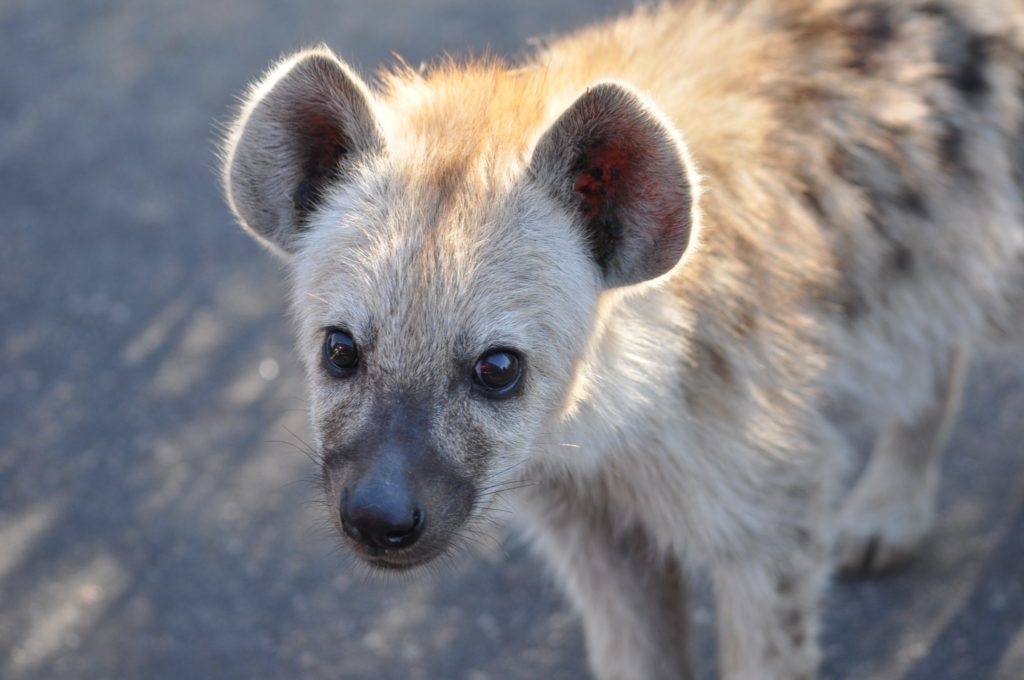

hello there, your site is very good.Following your site.
Thank you so much, I appreciate that! I will post more soon, I am working on pages of animals – pictures divided on each species. And I will also write and post photos of my home country Norway, show our lovely nature with mountains, fjords and beaches – and much more. Keep follow me! I am also at Facebook. and Instagram ( big5birgitte)